74 minutes
Overcoming Learning Anxiety
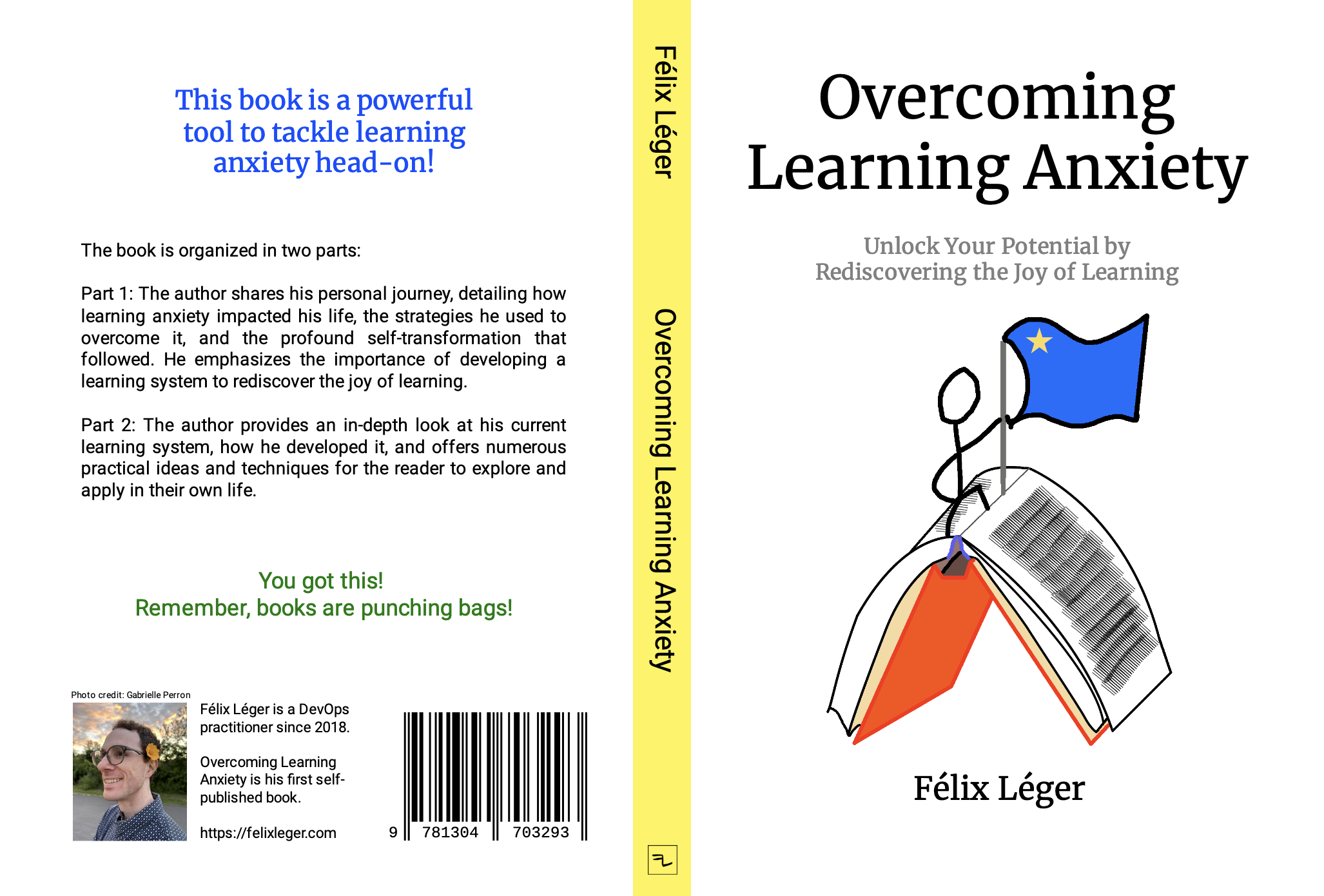
This text is available in print!
If you enjoyed this text, please consider supporting me by purchasing the print version at https://felx.cc/ola-store. That will allow you to try my four-steps method, as well as the book suplex, in real time!
If you know someone, friends or family, who might benefit from reading this text, please share!
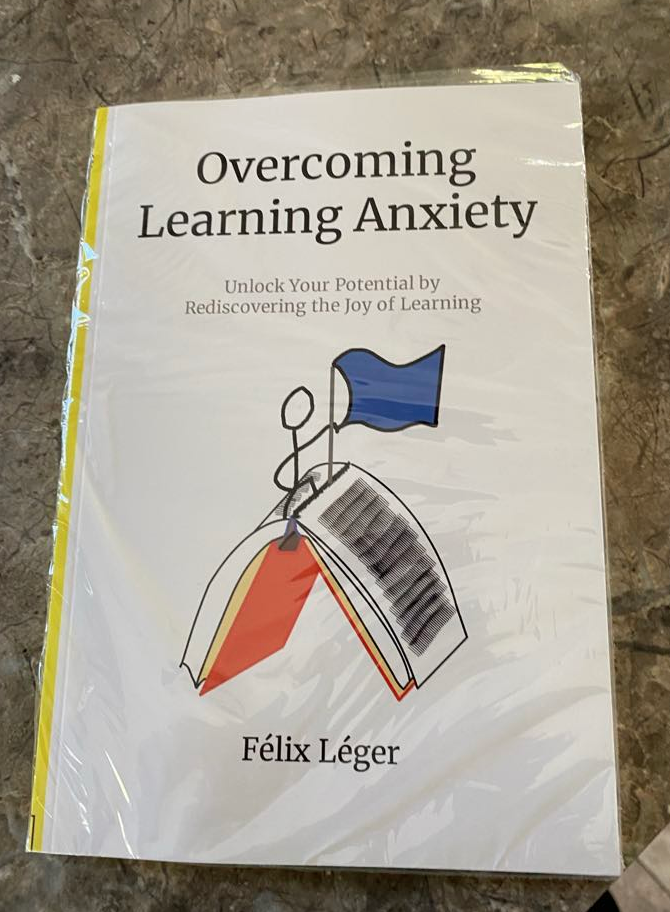
Acknowledgements
Thanks to my parents, Nadine & Dany, who have always been there for me.
Thanks to Gabrielle Perron for inspiring me every day, for teaching me that reading a book twice is inefficient, and for so much more. I love you.
Thanks to Alexandre Désilets-Benoit for his patience and for giving me my X.
Thanks to Mathieu Frenette for teaching me the book suplex and for pushing me beyond what I thought was possible.
Thanks to Benoît Dicaire for his mentorship, for introducing me to VanityURL, the Hugo bookshelf, and the Cornell note taking system. I don’t know how you find all this stuff, but please keep it coming!
Thanks to Avril Guarino for providing beautiful illustrations.
Thanks to my friends and colleagues at Portage Cybertech for making every day filled with joy and meaning.
Thanks to all who gave me their book recommendations over the years. I am lucky to be surrounded by so many curious and brilliant people. Never stop sharing your knowledge with others!
Thanks to Gene Kim for writing the books that gave me my Aha! moment.
Thanks to Edgar H. Schein for his research on learning anxiety.
Thanks to Matt Morris for publishing a video that became the foundation of my learning system.
Thanks to the following people who gave me feedback on this text: Gabrielle Perron (on multiple occasions), Paul Pedersen, Geneviève Perron, Suzanne Perron, Benoît Dicaire, Victor & Réjane Léger, Maxime Bergeron, Nicole Daoust, Mathieu Frenette, Julien Gaboriaud, Nadia Brousseau, Elaine Delage, and Catherine Proulx.
And thank you for giving this text a chance. I sincerely hope it will bring value to your life. If you have any feedback, I would love to receive it at felix@felixleger.com.
Preface
The illiterate of the 21st century will not be those who cannot read and write, but those who cannot learn, unlearn and relearn.
– Barry O’ Reilly, Unlearn
Ignorance is bliss. Would you agree?
Here’s another idea: All pleasant things have a cost.
Blissful ignorance costs missed opportunities. By accumulating missed opportunities, we unknowingly rob ourselves of the life we desire.
Nobody wants that.
Let’s flip the script. What brings opportunities?
Knowledge. What then is the cost of knowledge? That cost is time spent learning, which unfortunately is often painful.
Thus, we face life’s eternal challenge. To attain lasting happiness, we first have to choose a path of temporary suffering (learning), which goes against all our instincts. Too often, we instead walk the path of lasting suffering by choosing temporary joy (blissful ignorance).
We must forgive ourselves. Delaying happiness is not an easy choice to make, especially when we are not yet used to it. In fact, experiencing learning anxiety is like being addicted to ignorance. Can someone learn to prefer the pain of learning over the bliss of ignorance?
I believe so. We can learn to kick any bad habit. To do that, we must replace it with a good, meaningful habit.
The first step to healing a bad habit is to acknowledge the problem it poses, which requires knowledge of the problem in the first place. Unfortunately, anxious learners are less likely to learn about their condition if the idea of searching for clues feels unsafe to them to begin with. It is a sadly ironic predicament, especially because the topic of learning anxiety is rarely brought up in casual conversation. Indeed, I have yet to hear someone say anything about learning anxiety in my social circle, let alone hear anyone talk about how they were affected by this disease, how they worked through it, and how healing transformed their lives. How are anxious learners expected to heal and become comfortable with their own learning process if they lack the information that will allow them to acknowledge their problem?
“Be the change you want to see in the world” is a phrase that motivated me to write this book. I surely don’t know enough about the science of neurology to claim expertise on the topic of learning anxiety. However, I have experienced severe learning anxiety myself, which compels me to raise awareness of this condition while the experience is still fresh in my mind. Incredibly, overcoming learning anxiety is both the hardest and most gratifying thing I have ever done. By rediscovering joy in learning and in creating my own system of learning, I have found the key to unlimited mountains of wisdom that profoundly impacted every aspect of my identity. Where I once felt stuck in constantly repeating the same mistakes, I could now learn about the subject. This enlarged my perspective, made me see things differently, and suggested different ways to act. I cannot overstate it: This process changed my life.
As I write these lines, there is a single lingering fear in me: Am I preaching to the choir? What are the chances that people afraid of reading books make the decision to read this one? However slim those odds are, I must take them, if only as a token of gratitude for the authors that changed my life with their words.
I wish all anxious learners would know that they are not broken. They simply lost something: joy in learning. It can be rediscovered. In fact, restoring your joy in learning might be the most meaningful experience of your life. It certainly has been for me so far. This process doesn’t even need to take very long to have a big impact. It took me a year to radically change my learning habits, and I hope that by teaching you what I learned you will see improvements even faster than me. What we will attempt together in this book is changing how you approach information, so that it makes you feel powerful instead of anxious. All it requires is the willingness to fail, to learn, to succeed. You too can learn to love learning.
If there’s only one thing I’d want you to remember from all of this, it’s that anyone can experience learning anxiety and overcoming it requires a system of your own creation that will make learning a joyful experience for you.
Don’t worry. I will do everything I can to help you get there smoothly. I will tell you my story: how I discovered I had learning anxiety, the impact it had on my life, and the techniques I developed to work through it.
If you experience learning anxiety, my hope is to make you realize you are not alone and that there is a way out. You can overcome any obstacle that stands in your way, and you can even have fun while doing it. You might rediscover yourself and the world around you like you never have before. All it takes is the willingness to fail and learn from honest mistakes. And, perhaps, the urge to read a book or two. Or 105 .
Ready? Let’s begin.
Introduction
Awareness of wrongdoing is the starting point of healing, for he who does not know that he is doing wrong does not wish to be set right.
Lucius Annaeus Seneca, Letters on Ethics
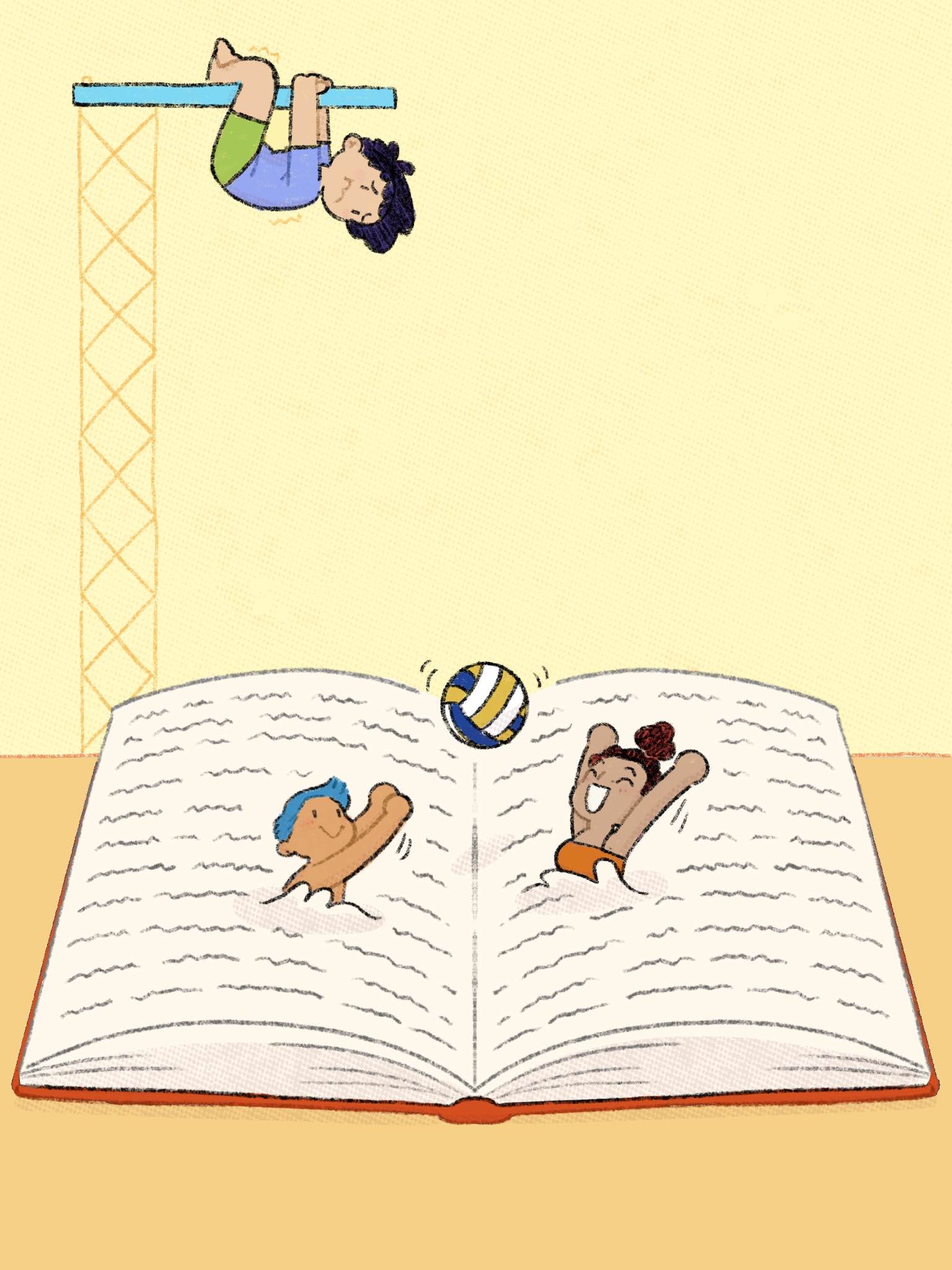
“Learning anxiety” is a complex emotion.
I love the image above because it illustrates perfectly how I felt for most of my life. The black-haired person hanging for dear life on the diving board is caught in a difficult spot. That used to be me. As much as they would like to dive in the book and join their friends, the jump seems too big. Too difficult. Too dangerous.
Having learned feels great. Learning, on the other hand, can fill us with dread. We want to let go, take a chance, and immerse ourselves in knowledge… but it’s not that easy. What if we fall on our face? What if it hurts bad? What if we look foolish? What if we drown? What comes next after a big failure? Our fear can make us permanently frozen in place. We go home dry, defeated, and aware of our ignorance.
That is how learning anxiety keeps us stuck in life. It blocks us from taking the first step toward trying new things. It sucks.
I wasn’t always aware of how bad my learning anxiety was and I had no idea of the choke hold it had on my life. I’m convinced that most people who suffer this condition don’t realize it either.
In my younger years, to an outsider, I must have looked like a virtuoso of everything I touched. Most people would probably never have guessed I had learning anxiety. I could improvise on the piano with emotion at age 9 after a single year of home classes. I intuitively understood Mathematics from a young age up to well into my college years. Words flowed naturally through me when I was writing, both in French and in English. I could juggle and ride kilometers on a unicycle. And you should have seen me on stage with a flower stick! I had a quick mind, piercing eyes and a sharp sense of humor. I could dominate anyone at any (video) game I picked up. I was never the strongest boy, but my charm and my wits were such that if I decided to get something done, no matter how difficult, I would always find a way. And, as surprising as this may sound, I was still popular at school. I had more friends than most. My teachers loved me. My friends’ parents loved me. I was never bullied. To summarize, I had it all, and it all felt easy…
Giftedness refers to an exceptional level of natural ability or talent in one or more areas, such as intellectual, creative, artistic, or leadership capacities. It is often recognized in children who show advanced abilities compared to their peers.
Well. My giftedness turned out to be a curse.
All light has a shadow. When it comes to giftedness, there is one major downside. When you are used to being good at everything, as soon as you no longer are for a particular activity, your ego can’t handle it, so you often give up too easily. This comes at a price that is worth more than talent: lack of grit.
The trained eye would have noticed a pattern in me. As soon as I found someone better than me at something, this didn’t inspire me, nor make me curious, nor turn me into a fan. It made me give up! When I felt like I had reached my depth at something, I lost all interest in pushing forward and improving. There were many hints of that, in hindsight.
As good as my flower stick abilities were, I snubbed techniques that were out of my reach by labelling them as “less interesting.” I despised losing at board games that didn’t rely on luck. For example, I stopped playing Chess as soon as I started losing. I “lost interest” in karate as soon as I got my first hit in the face. I never learned how to cook, because I never felt good at it.
So many times, I passed by opportunities to learn and practice new skills simply because I was afraid of having to admit failure. I would instead spend my days alone in my room playing video games that made me feel like a champion.
All these memories are bittersweet. I had no idea of the vacuum that was growing in my soul. I didn’t realize how much I was stuck in my old ways. Life had given me many abilities but left me with the impression that new ones could not be developed. I had a fixed mindset.
Unsolved problems have the frustrating habit of building up until they turn into a crisis. This is where our story begins – with an existential crisis.
Part 1: Escaping the Valley of Despair
Chapter 1: The Anxiety Begins
Realize as early as possible that you have chosen your career for the wrong reasons, before your confidence takes a hit.
– Robert Greene, Mastery
In 2017, freshly graduated from McGill University and feeling ready to tackle the world, I started working as a junior machine learning scientist for a newly formed startup called Proximity HCI (now known as Contxtful). I had just finished my Masters thesis in particle Physics and, having recently acquired a fondness for computers through my research, was ready to jump into the world of software development1.
A few months into my new job, it became apparent that things were clearly not working out: I was terrible at machine learning. There was no science to my methods, I just cobbled algorithms together and hoped they would work magically. With machine learning, I was simply “not on my X”, as we say in French, meaning I wasn’t in the right context to fulfill my potential. As I naturally drifted towards handling the IT of the company and discovering automated deployment pipelines, my then-manager (and trusted friend!) Alexandre Désilets-Benoit said something that would change my life:
“You know what? I think DevOps would be a good fit for you.”
For someone with a self-diagnosed impostor syndrome, receiving this kind of feedback is a mixed bag. On one hand, it finally explained why I was having such a difficult time accomplishing the tasks I was given. This was a relief. “Of course, it all makes sense now! I’m bad at machine learning because, deep down, I’m a DevOps! Yes, change my title now, please! This will fix all my problems,” I would unironically say to myself.
On the other hand, I now faced an undodgeable question: “What the heck is DevOps, anyway?”
You can probably imagine how, depending on the day, my impostor syndrome simply got out of control. I’d started as a humble Physicist then changed career paths after my Masters degree to become a Machine Learning scientist, out of nowhere. I then discovered that I was even worse at that job, so much so that my boss recommended another career change into a field I knew absolutely nothing about. I was rightfully terrified!
Not wanting to waste any time, I feverishly started Googling the most basic things, like “How to DevOps?” and “What is DevOps?”. To give you an idea of the steepness of the learning curve I was faced with, check out this introductory video from TechWorld with Nina and count how many times something along the lines of “you need to learn / know / understand” is said:
(I counted over 30 occurrences.)
Every search result required me to do at least three other searches to understand what basic sentences meant. For a while, it felt like I was surrounded by buzzwords with no clear explanations in sight. The rabbit hole just kept getting deeper and deeper. Oh how I wished Jimmy Neutron’s “book gum” was real!
This process of drinking from a fire hose of information while struggling to get anything done lasted years, and it was unpleasant. I felt useless. I felt ashamed. I wished I could go back in time and learn about Agile, CI/CD, and other DevOps requirements during my studies instead of having filled my brain with equations of motion that I had no use for. In short, at 27 years of age, I already felt like I had missed the boat, and with each passing day felt more like giving up.
I felt deeply that I wasn’t accomplishing as much as I should, despite coming home exhausted from work each day. I had no idea how to solve my problems, and the articles I found in my research were beyond my comprehension. From the outside, it might have looked like this:
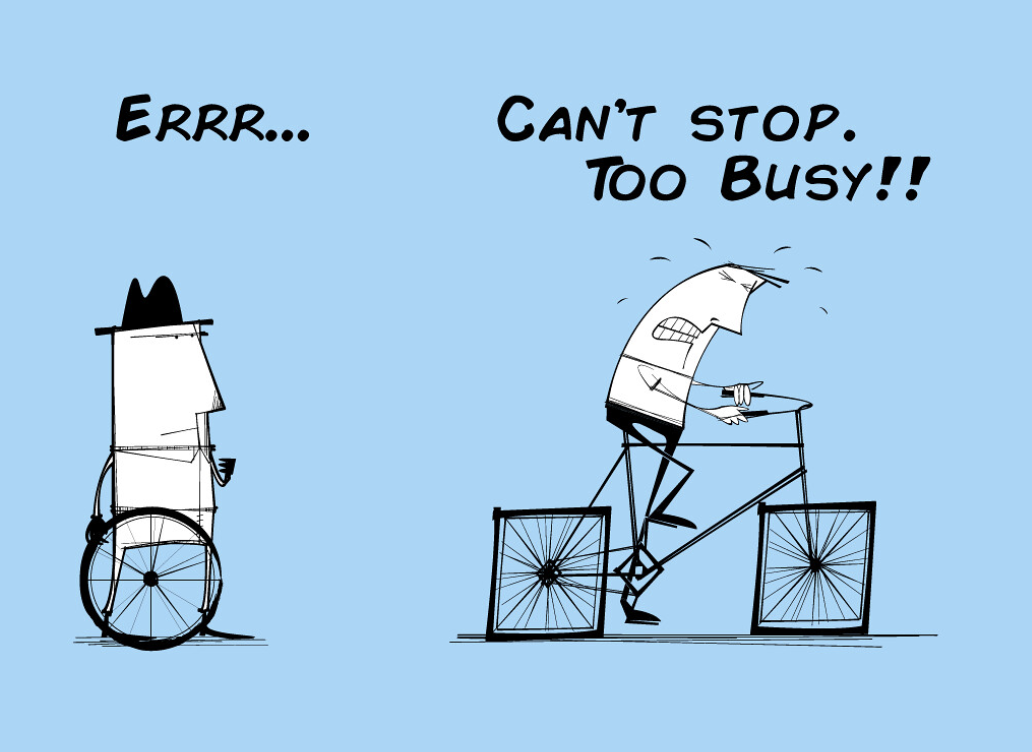
The only thing pushing me forward was the fact that my colleagues depended on my work, as amateurish as it was. I could imagine going down in a big ball of fire, but I didn’t want my colleagues to suffer the fall with me. I wanted them to thrive and excel at their respective tasks. Ironically, I now believe this is precisely the kind of mindset that drives the DevOps philosophy : do everything you can to maximize the value your peers can deliver. However, I was simply too discouraged at the time to realize this.
In 2019, as I was going on vacation, I stumbled upon a book called The Phoenix Project, which seemed really popular in the DevOps space as an entry point into the subject matter. It was written as a novel, so I thought: “Ah! This is perfect material to read on the beach, without any pressure to learn. This should be fun.”
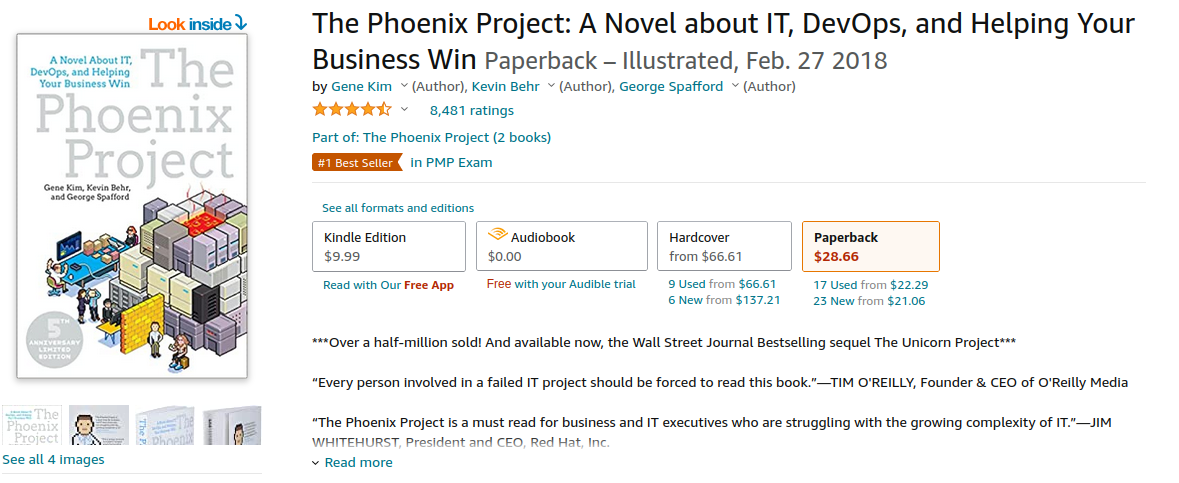
As it turns out, it was great fun indeed! There are many reasons for this, I believe. Firstly, the book is, of course, very well written. It wouldn’t sell over 500,000 copies if it wasn’t. I felt invested with the story and its cast of characters that reminded me of my daily interactions with my colleagues. Secondly, and more importantly, the fact that I was open to the material and didn’t feel pressured to understand everything right away made a big difference. Learning felt optional, and so my anxiety had no reason to get triggered. Finally, and this is key, I enjoyed this book because I read it from cover to cover. This is something I will come back to later…
In just one week, I had finished reading my first DevOps book. Woohoo! I felt like I was ready to conquer the world. My mind was now filled with ideas and I was excited to try them out. The Phoenix Project subtly advertised for another book from the same author, The DevOps Handbook, which supposedly contained everything you needed to know to propel your business forward like the protagonist of The Phoenix Project did. I felt ready. It was now my turn to be the main character. Bring it on!
Chapter 2: Mount Stupid
You do not rise to the level of your goals. You fall to the level of your systems.
– James Clear, Atomic Habits
I ordered my copy of The DevOps Handbook in 2019. Spoiler alert: I finished it on August 6, 2022. What happened for it to take me so long?
The Dunning-Kruger effect is what happened. It is a phenomenon that happens whenever we learn something new. To summarize, in the process of becoming a master, there is a transitional period where the learner goes from being overly confident to feeling completely ignorant, despite constant progress in their learning.
This peak of overconfidence is known as Mount Stupid, and at this point of the story I had made it to its peak. Some people call this stage “premature enlightenment.” It is often at this stage where we make the most mistakes. My confidence in my ability to learn from reading had risen above my actual abilities, and I was about to learn it the hard way.
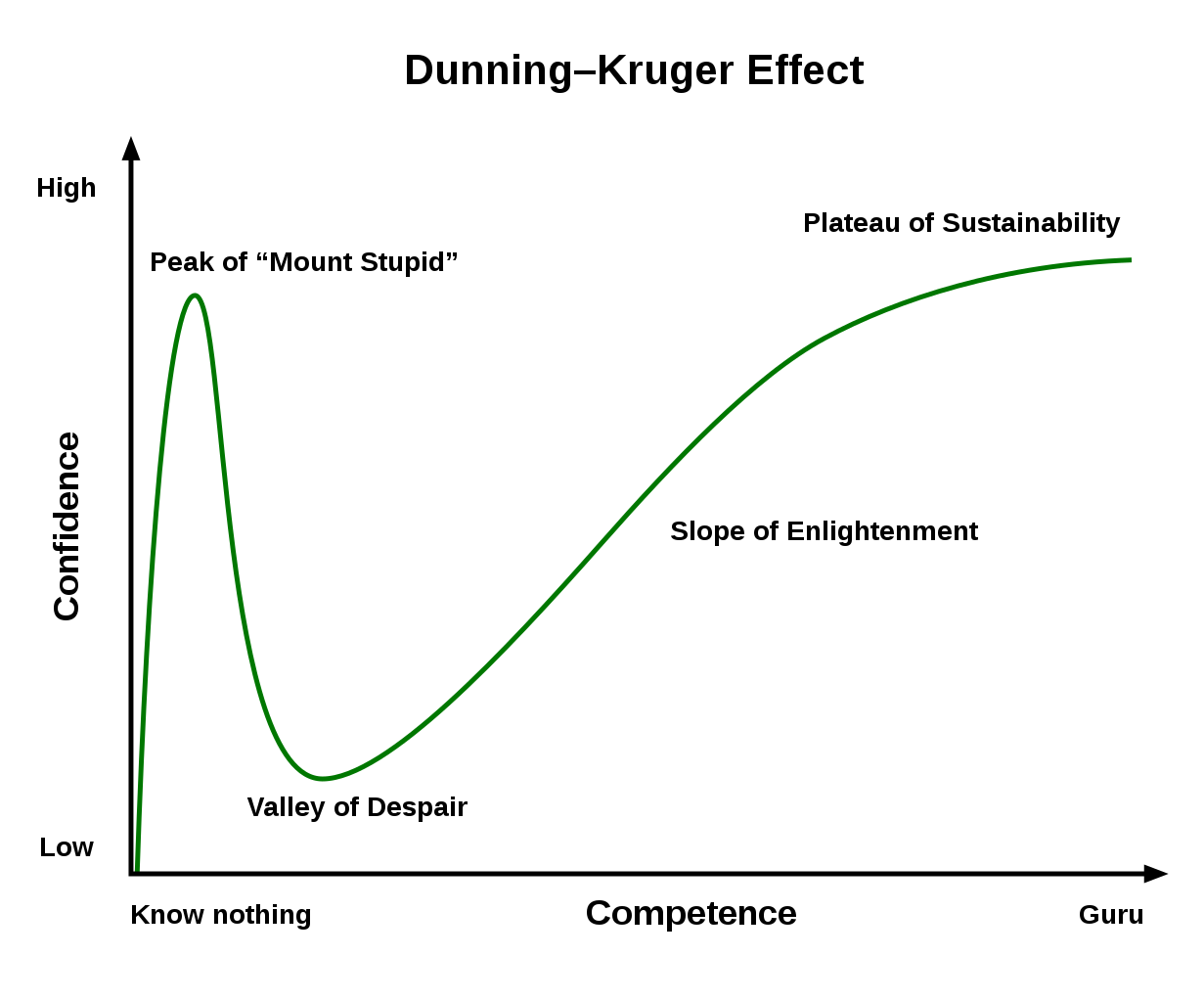
I thought reading the Phoenix Project was the breakthrough to end all breakthroughs. Little did I know, it was only the beginning of my journey, and I was in for quite the slump. After only a few chapters, I began to feel dizzy. The DevOps Handbook wasn’t like the Phoenix Project. It was a real book, one that required actual effort to read through. It laid the truth bare: I had no idea what I had gotten myself into. I quickly fell into the Valley of Despair.
Every new bit of information felt like it took the place of another one in my head, like a musical chair of knowledge. For example, I had trouble remembering what the Three Ways of DevOps stood for, even though they were central parts of both the Phoenix Project and the handbook. It felt like I was drowning in information. If the Phoenix Project managed to organically sneak in a reasonable amount of information within the context of the story, the DevOps Handbook proved to be too much for me, regardless of how smart I thought I was. There seemed to be no time for relaxation – the handbook simply lined the knowledge nuggets relentlessly one after the other. It confirmed that I was nothing but an impostor.
Very early on, I could feel my reading velocity diminish as I advanced through my physical copy. Indeed, I asked myself, what is the point of reading if you can’t remember anything? I took a stab at the digital version on my Kobo to see if that could help (I was very big on e-readers at the time2), but I got the same result – initial progress was quick, and then everything ground to a halt.
Reluctantly, I shelved the handbook both physically and digitally, feeling ashamed and defeated. I felt even more like an impostor and the fact I couldn’t get through the DevOps Handbook proved it. I became fixated on the notion that I was a fake DevOps.
This pattern of excitement for learning leading to bitter disillusionment was, as you might have guessed, not limited to the DevOps Handbook. Throughout most of my time at Contxtful (almost five years), I was given the opportunity to learn, and by my own account, failed to do so more than I succeeded. I was going from Mount Stupid to Mount Stupid, never making it through any Valley of Despair.
Eventually, the feeling of being unable to reach my full potential at Contxtful (and potentially hurting the company as a result) led me to quit my job and join nesto, in the hope that there lied the key that would unlock my potential. And would you believe it, each member of nesto’s DevOps team received their own copy of the DevOps Handbook as a welcome gift. This book was following me everywhere I went! At this point, so much time had elapsed since I had started reading it that the second edition of the Handbook had now come out. I was embarrassed.
Surely there was some secret sauce at nesto that would allow me to succeed where I failed at Contxtful. What new possibilities would allow me to escape the dreaded Valley of Despair?
The answer came quickly: for the first time in my life, I was threatened with termination.
Chapter 3: Aha!
Why has nobody told me this before?
– Dr Julie Smith, Why Has Nobody Told Me This Before?
In June 2022, three months after joining the nesto DevOps team, I received the unfortunate news: I was getting a probation extension. I wasn’t quite cutting it in the workplace. I had trouble learning the new tools and processes required to become a productive teammate. New concepts and important details eluded me. To summarize, I was failing, and hard. If I didn’t manage to course-correct within two months, I could kiss my new job goodbye.
This is what put me into survival mode, where the hopelessness of the situation was such that it finally opened me up to learning. I couldn’t bear the thought of being rejected from my new job. It would have made leaving Contxtful feel like a mistake, and would have left me without a plan B. I had to get through that probation period at nesto, no matter what it cost me.
I had never explicitly been told by a manager that I was not pulling my own weight. I wasn’t going to waste this opportunity to show the world what I could do when given proper motivation. So I got to work, big time. My focus in mid-June was higher than ever thanks to survival instincts that kicked into high gear. One of my first personal objectives was to get through the DevOps Handbook before the end of my extended probation, partly to prove to myself that I could accomplish something, for once.
And then, something magical happened. At page 107, three years after I had started The DevOps Handbook, I found a sentence that resonated with me.
In the team, we want to help overcome learning anxiety.
“Wait, what?”
Learning anxiety. Those two words echoed in my mind and shed a light on some uncomfortable emotions I had been experiencing for so long. What was that all about? How had I never heard of this before?
I searched online for more information about this condition and, sure enough, I stumbled upon a passage that was describing my reality with alarming precision:
There are two kinds of anxiety associated with learning: “learning anxiety” and “survival anxiety.” Learning anxiety comes from being afraid to try something new for fear that it will be too difficult, that we will look stupid in the attempt, or that we will have to part from old habits that have worked for us in the past. Learning something new can cast us as the deviant in the groups we belong to. It can threaten our self-esteem and, in extreme cases, even our identity.
You can’t talk people out of their learning anxieties; they’re the basis for resistance to change. And given the intensity of those fears, none of us would ever try something new unless we experienced the second form of anxiety, survival anxiety—the horrible realization that in order to make it, you’re going to have to change. Like prisoners of war, potential learners experience so much hopelessness through survival anxiety that eventually they become open to the possibility of learning. But even this dejection is not necessarily enough. Individuals can remain in a state of despair permanently.
(Edgar H. Schein, The Anxiety of Learning)
For the first time in my life, I saw the flaw in me for what it was. Dr. Schein was describing exactly how I’d felt during my entire career. First, learning anxiety kept me in the Valley of Despair. Then, the risk of losing my job at nesto made me experience survival anxiety that was greater than my learning anxiety, which finally made me open to learning.
This was my Aha! moment. My problem was learning anxiety all along. It was making me afraid of learning, that is, I was afraid of failing, which made me afraid of trying, which kept me stuck. That’s what kept wasting my time. That’s what kept me in the Valley of Despair!
I was made plainly aware that if I wanted to learn the necessary skills that would allow me to keep my job, I would first have to learn how to beat this learning anxiety out of me. I would have to make learning things feel safe.
But how?
Chapter 4: Opening Pandora’s Box
If you want to teach people a new way of thinking, don’t bother to teach them. Instead, give them a tool, the use of which will lead to new ways of thinking.
Peter Senge, The Necessary Revolution
The hardest part of making a breakthrough is finding the right problem to solve. I had just identified my problem, learning anxiety. You can bet I wanted revenge for all the precious years it made me waste.
I became much more open to trying new things. I worked overtime to better understand how some complex programs worked. I recorded video demonstrations to motivate myself to keep trying things. I celebrated whatever small successes I could accomplish. It was tedious, but I felt I was going in the right direction.
One evening, our team leader Mathieu Frenette welcomed us into his apartment for a special occasion. It was a nice bonding experience for all of us. My latest efforts had made me feel more welcomed in the team. I felt better about participating in discussions. I will never forget the moment when Mathieu came back with a stack of books as we were trying different flavors of spicy chocolate on his patio. There were books of all kinds, none related to our current job. He was eager to share what he was learning about.
None of the content on display fascinated me more than the way Mathieu held those books. It felt wrong, gross, even. Never in my life had I seen someone hold a book like that. It sent shivers down my spine. It felt like he was breaking an unwritten rule. Here’s what it looked like:
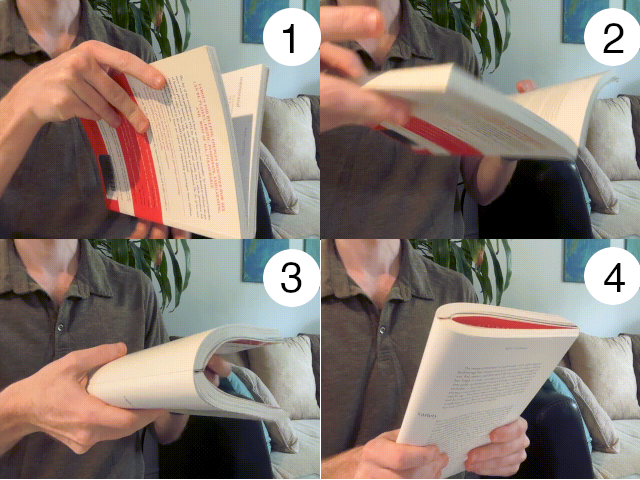
I asked Mathieu why he was folding his books this way. He simply replied with his characteristic grin: “It’s so much more comfortable!”
That made me pause. Could this have been my missing ingredient all along?
Flashback
About 10 years ago, I was a relatively money-poor grad student. I was short on cash and keeping my old course textbooks was not something I could afford to do. So I took great care of these textbooks, seldom highlighting or writing in them in order to boost their eventual sale price.
Unfortunately, this strategy was sub-optimal. For an extra $40 per book sold, I was taking the risk of having a lesser learning experience. Without realizing it, I always saw my books as someone else’s items that I was borrowing, or some item that might become desirable in the future, like Pokémon trading cards. This was so wrong. As a student, I was depriving myself of potentially useful learning tools in fear of wasting resources (money). I was like a boxer who was afraid to damage his punching bag. Maybe I had this mindset since I was used to owning collectible items (see how and why I got rid of my video game collection). Whatever the reason, I’m glad I made it this far in life despite this backwards mindset, because I don’t plan on doing this ever again.
Let’s think about punching bags for a moment. If someone was standing in a gym next to their punching bag, you would probably understand that whatever damage the bag exhibits went directly into making that person stronger, punch after punch, and kick after kick. If you had to challenge someone, you’d probably pick the fighter with a seemingly untouched punching bag in their gym, since this means they probably hadn’t trained at all.

The book suplex made something click in my head. It opened Pandora’s box. Books are punching bags for our brain. They are meant to be used however necessary to make you stronger.
Let me get preachy about it. It’s ok to damage your books. That’s the point of owning them. You are meant to be free to bend them, write in them, fold them in any way that allows you to learn faster. Rip pages off if you must. Doodle in them if you must. Your copy is yours. Please don’t think of books as decorations; think of them as food that nourishes your soul!
Use your books.
If you damaged a book to the point that you believe it to be unusable by anyone else, it is ok to put it in a recycling bin afterward. Few people realize how invaluable our ability to learn truly is – it is well worth a few hundred pages if it can change your life and the lives of others around you. In summary, my final advice on the matter is to stop respecting books, and to start respecting how your brain learns.
You can’t imagine how joyful I was to suplex the DevOps Handbook. It had held me back for so long, I felt like I was getting revenge. It was such a cathartic experience. Page after page, I was folding it, compressing it, damaging it, writing in it, and with each passing day, I saw the book get more and more used by my doings. The creaks on the spine were becoming visible. I was making progress. I hadn’t yet learned how to take notes (we’ll get to that in Chapter 5), but I was making more progress than ever, simply because the act of using my hands to flatten the book made me feel powerful. The book suplex was an immense upgrade when it came to reading:
- it’s more comfortable for longer periods of time, because it allows a firmer grip
- it’s less distracting, because you can only see one page at a time
- it leaves a mark (remember, books are punching bags!)
To summarize, here is what a full book suplex looks like:

So, here is my challenge to you. Before moving on to Part 2, find a book you feel OK experimenting on. If you choose to use the book you’re holding right now, you will seriously make my day (I’m not kidding!). Apply a clean, strong book suplex to it, as flat as you can make it. It doesn’t matter if it is a softcover or hardcover; the book suplex will work on any book, including the dictionary. Most people fear that the book will instantly break in half, but in my experience that never happens. You generally have to work pretty hard to even get a single page to fall out of a book, trust me. Even if it does, it’s not a big deal. If you follow my method, you won’t even keep the book when you are done with it! Show it who’s the boss. Yes, it’s going to leave a mark on the spine, but that’s also the point. See how this new experience feels on your hands, on your eyes. Get comfortable. Try suplexing the early pages of the book, then the middle pages, then the final pages. Observe the difference. Realize that books have been around for hundreds of years and that they are tough, dependable objects.
You don’t have to try it if it makes you uncomfortable: I don’t want to force you to break your precious things. Indeed, I take no responsibility in the damage anyone makes to their own material 😉. Before I move on, though, I will point out that if you feel like you have tried everything and that learning anxiety is still looming over you, it might be worth giving the book suplex a shot, if only for the cathartic experience of using your hands to crush something that made you feel like a prisoner.
Freedom!!
Part 2: Climbing the Slope of Enlightenment
Chapter 5: Creating a System of Learning
You gotta kiss a lot of frogs before you find a prince.
– Adam Grant, Originals
So, I knew how to hold a book. Big whoop. This didn’t change the fact that after reading 10 pages, I couldn’t contain all the information I was reading. If 10 pages of info coming into my brain means 10 pages of info coming out, that does not count as learning. That is the equivalent of passively listening to the radio while driving. All your mind really memorizes are the ads.
This time, something was different though. Folding my paperback opened Pandora’s box. Now that I was unafraid to hurt the resell value of my books, a world of possibilities became accessible.
Many attempts were made before stumbling upon my learning system. We learn by doing. At first, I tried to take notes directly in the book using a pen. While this new experience felt great to do in the moment, it didn’t have any lasting effect. I then tried to do the same thing with a yellow highlighter, as I had heard in primary school that the color yellow makes it easier to remember things. That was baloney. The problem in both cases is that having to flip through tens of pages just to view my notes was inconvenient. While it felt good to interact with the words on the pages, it didn’t help me remember anything!
It was at that moment that my partner Gabrielle said something very wise:
You should never have to read a book or textbook more than once. If you take good notes, once you finish a book, you can consider yourself done with it.
She was so right about that, even though it took me a few days to admit it. This went against my core belief that books are meant to be kept as reference material. After all, almost every content creator on the Internet who is a self-declared book reader will proudly display their bookshelf in the background of their videos. When I realized the wisdom in Gabrielle’s words, I decided to be a contrarian. My library, if I were to have one, would be filled by books I wrote, and empty of books I read. This gave me a new motivation: whatever system I’d use for learning, it would be a system that doesn’t depend on maintaining access to the source material. In fact, after she told me this, I realized the best course of action was to systematically give the book away once I am done reading it. It is the simplest, safest and most elegant way to ensure my learning system is working.
I didn’t have to search for very long after that insight to have my eureka moment. Armed with the rule of giving my book away once I’m done reading it, I started searching for ideas online that would cement my learning system. This six-minutes long video from Matt Morris titled 'How to Read a Book for Maximum Learning' fit the bill.
What I want you to remember from this chapter is that my learning system didn’t just fall on me from the heavens. I had to look for it. I failed a bunch of times before stumbling upon a process that worked for me. I asked my partner for help and suggestions when I realized I was out of ideas. I searched on YouTube for insight. I was at my most vulnerable then, because I was basically admitting that I needed help. I had overcome my learning anxiety on the topic of learning itself.
It might not look like much, just asking someone or a search engine for help, but in fact this is huge! It requires tremendous courage to try new things, to fall on your face, to ask for help. I tip my hat to anyone who experiences personal hardships and has the courage to look for assistance before trying again. That’s how major psychological breakthroughs begin. In a way, that is what you chose to do by starting to read this text (and look at you, still reading!). So, let’s take a minute to celebrate the fact that you chose to hear my advice, and that despite all the distractions in the world, you are still paying attention and making progress. You’re awesome!
I can’t say for sure if your final learning system will look like mine. But however your brain learns, you’ll have to fail before you get good. So, remember that each humbling failure is a step closer to mastery, and rejoice that you are making real progress.
Alright, enough talking, let’s start doing. It’s time I share with you how I learn.
Chapter 6: My Current Learning System
Acknowledging your mistakes is not the same as surrendering to them. It’s the first step toward overcoming them.
Success consists of going from failure to failure without loss of enthusiasm.
– Ray Dalio, Principles
In this chapter, I will teach you exactly how I learned everything I know. You will notice that my method relies on using physical books. If you’d rather read digital books, the main steps will stay roughly the same. If you learn better from audiobooks or podcasts, you might have to find workarounds.
Know that it’s ok if your preferred way of learning is different from mine. At the end of the day, what matters is that you find joy in using your system and that it gives you the results you want.
Alright, let’s get started. If you want to try my learning system, you will need, in addition to your chosen book:
- a notebook
- a pen
- a highlighter
- a ruler that fits in your notebook
Make sure that each of these items are objects that you personally enjoy using. I’ll nerd out in a later section of the Appendix about the hardware I use, but for now just focus on making sure that whatever gear you end up choosing makes you want to read and write more, not less!
We learn by doing. If you can, I suggest you try to do these steps in real time on this text as you learn about them.
Step 1: Read and highlight the golden nuggets
Crack open the book at page 1 (or simply continue reading here). We are embarking on a journey. If you didn’t try the book suplex yet, consider doing it now. Have a highlighter in your hand and start reading. Highlight whatever golden nuggets of information you find interesting, whatever the reason. That’s it!
Whenever I highlight something, I don’t care if this is something the author expected me to memorize or not. If a sentence resonates with me, if I’d like to keep this sentence floating in my brain, that’s the signal to highlight it. Often I even take pride in highlighting a little detail that feels irrelevant in the scope of the whole book but that I connect with. Do not be scared by this freedom: follow your instinct. There is no test at the end. 3
As you read, don’t bother trying to remember everything. Personally, when I turn a page, I feel completely OK not remembering what I just read! Read your book like you’re watching a TV show or listening to a podcast. Highlight as you go and know that we will come back to collect all these little knowledge nuggets later.
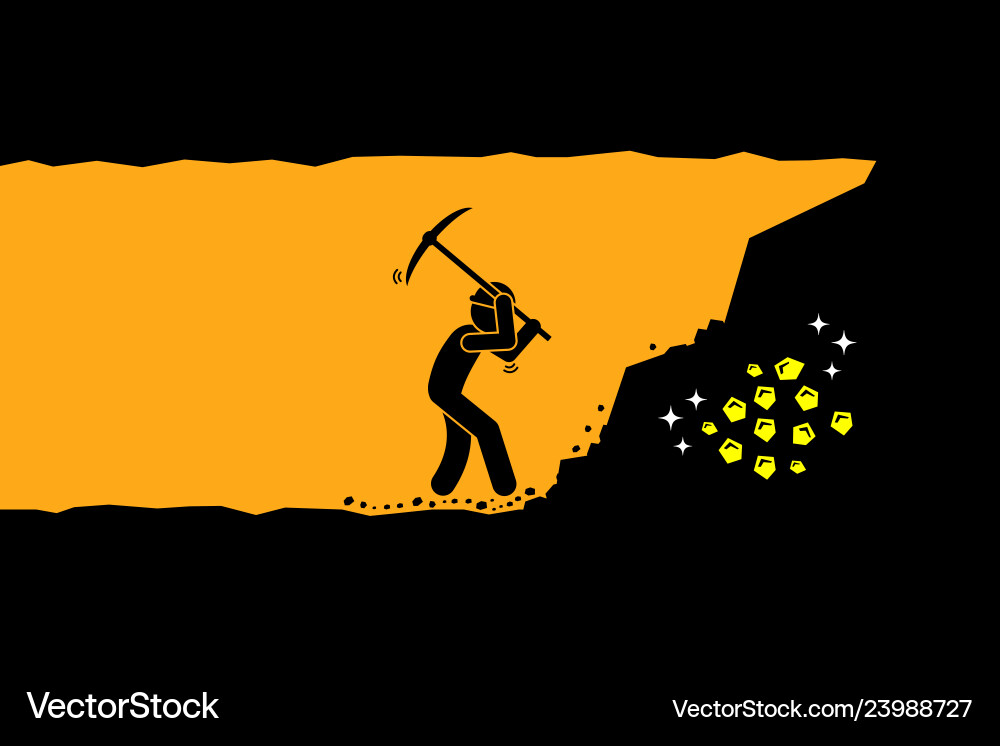
Step 2: Write down your highlights
When you’re done with the book (or whenever you feel like it, really!), get your notebook out. We will now go back to the beginning of the book and flip page by page looking for any nugget you identified earlier.
Why take the time to write out by hand all these nuggets? I’m glad you asked.
Firstly, this will make it much easier for you to focus on the useful content of the book whenever you want to revisit its ideas later. Think about it: your notes will be all the good stuff. No distractions. Pure gold, selected by you!
Secondly, and in my opinion most importantly, writing a nugget forces it to get decoded by your brain, even if only briefly. Indeed, any sentence that goes into your notebook was seen by your eye, decoded by your brain, and crafted by your hand’s muscles. For your memory, this process is much richer than just reading words, which only involves the eye and the brain. By writing your highlights, you are immersing your entire body in the book. Reading diagonally is often tempting; writing diagonally is much more difficult to pull off, if not impossible. It’s a hard experience to describe, as it is both incredibly simple and profoundly powerful. I think you’ll have to give it a shot to really get it.
Thirdly, as I wrote earlier in Chapter 5, you want to do everything you can to not depend on having access to the book once you’re done with it. The goal of producing complete notes is to allow you to unshackle this knowledge from the book and claim it as your own.
In this process of going through the book a second time to collect your nuggets, feel free to not even look at the pages without highlights. I mean, why would you? You already read them and clearly haven’t identified anything of value. Trust your instinct: move on! It feels good when you can skip over a bunch of pages empty of nuggets.
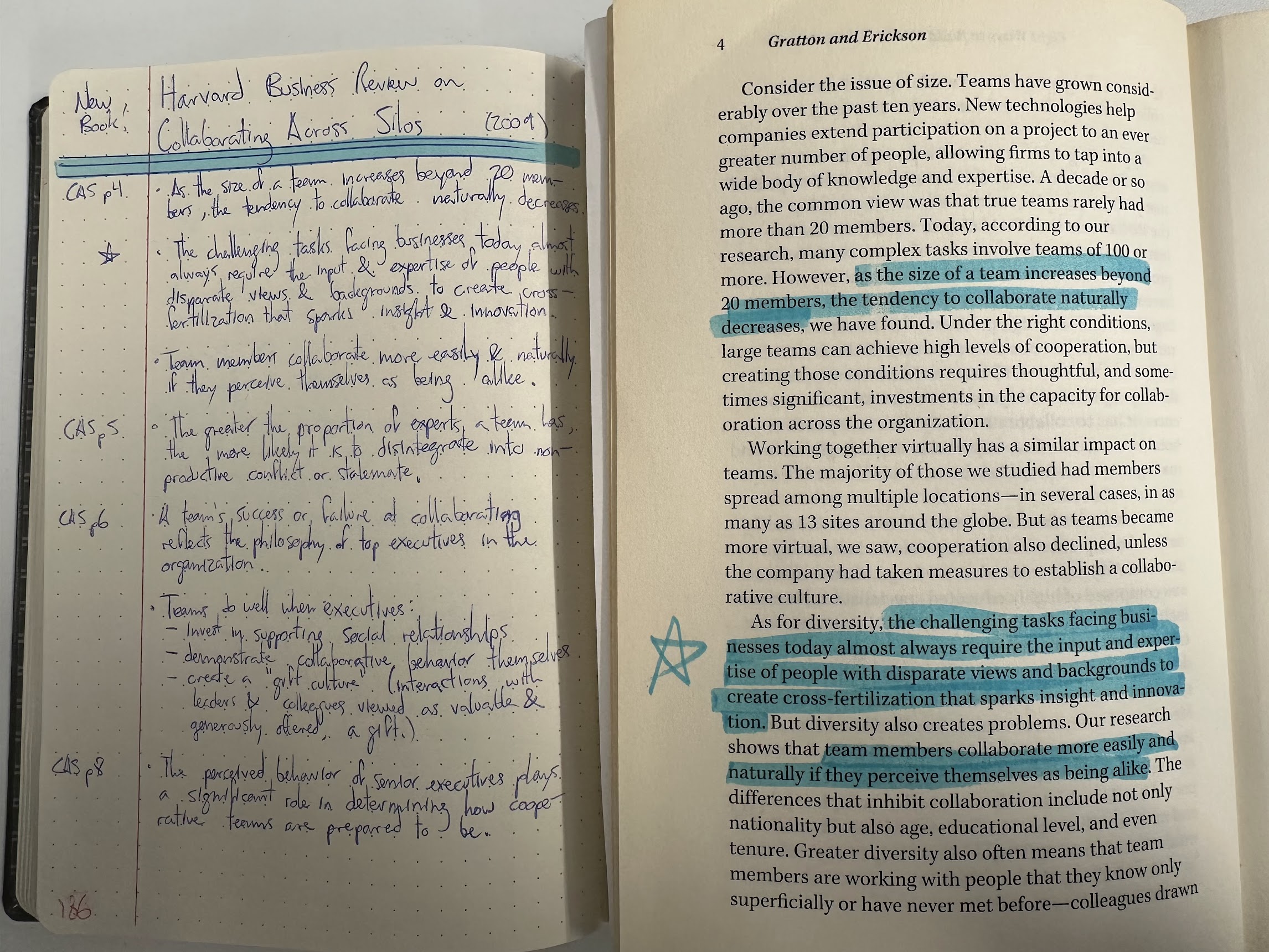
As you can see in the picture above, I don’t really bother rephrasing the quotes from the book. The only time I’ll rephrase something is if I can make it shorter, or if I find the original sentence hard to understand. Your mileage may vary. Some people tell me you must reword quotes you get from a book. To each their own!
Personally, I love this step of writing highlights on paper. I often do this while listening to music, or while watching a video in the background. It feels like knitting and is very relaxing. Just go at your own pace and stop when you’ve had your fill.
Step 3: Find your Star Quotes
So, you read a book, you made some highlights, and you took some notes. Are all notes good? On average, I would say about 60% of them are truly worth keeping. Indeed, some quotes are redundant, or don’t make much sense out of context. Therefore, a very powerful thing I enjoy doing right before I review a book is reading my notes one last time and identifying which quotes I want to include in my review. I call those Star Quotes.
This process is useful because it forces you to:
- read the material one more time, which ups your chances of remembering it later
- remove the quotes you initially liked, but now find they don’t really have lasting value
What is neat in finding your Star Quotes is that you follow exactly the same method you developed in Step 1, but on your notes. Of course, you might be tempted to highlight most of the material found in your notes, and that’s ok. That means your initial selection was relevant!
You can see in the image below the quotes identified by a bit of highlighting. These are my Star Quotes. They will be included in my review of the book, which happens in the next step.
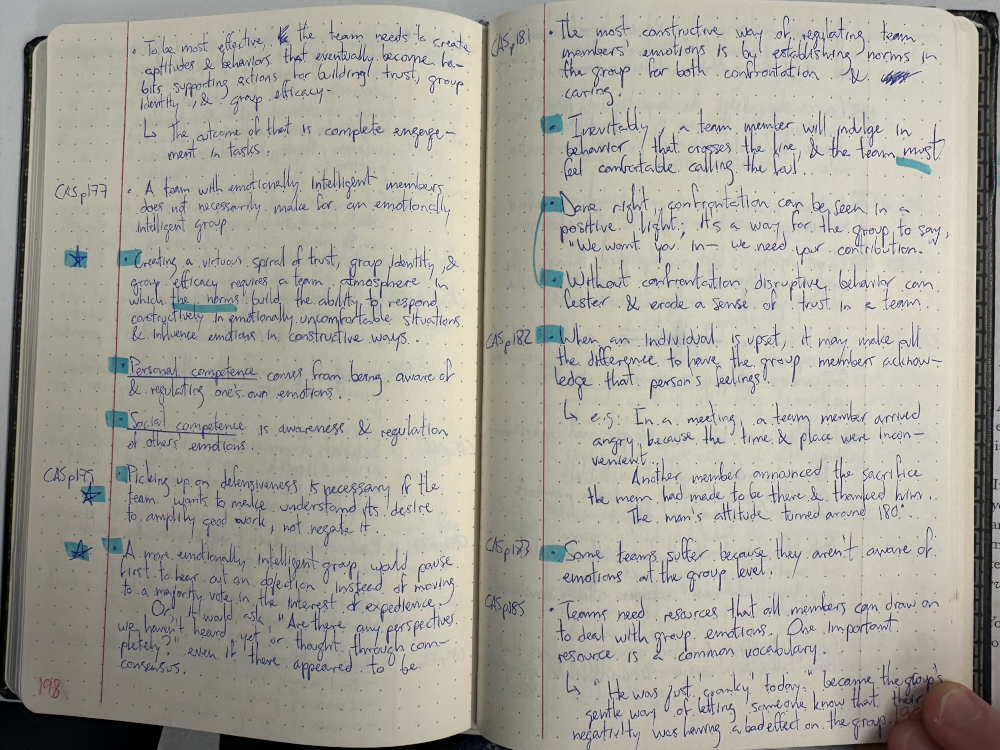
Psst, you can access a compilation of all my Star Quotes if you are interested.
Step 4: Write down your opinion of the book
This might seem like overkill to most, but I wouldn’t even think of skipping this step. Once I’m done with a book, I want to formulate my own opinion about what I just read in the form of a review. This is what cements it in my brain and makes me feel like I own the ideas I’m discussing.
Since I use my website as a platform for reviewing the books I read, sometimes I get stage fright. “What will people think of me if I write this and that in my review?” In a way, reviewing books also forces me to face my fear of rejection.
In my reviews, I give myself the freedom to be as detailed or as brief as I want. In a way, I treat a review like an artist would treat a canvas: whatever ends up there is simply a reflection of how I felt about the book. There’s a good amount of intuition that goes into this process. Sure, I try to put a minimum of effort into my reviews, but I also try not to overdo it. After all, this is something I do for myself. I must find enjoyment in it, otherwise I know I will get discouraged.
Finally, I suggest you include in your review all the Star Quotes you
identified in Step 3. It will be very
convenient to be able to use Ctrl-F (or grep) to search specific
quotes later.
As an example, here is the latest review I wrote. Feel free to copy my format if you want or make your own. In the end, what matters is that you create a pattern of work that tricks your brain into really thinking about these ideas and have them make sense to you. You get bonus points if you make this review public and share your handwritten notes: not only are you sharing your knowledge, but you also encourage people to participate in your journey and initiate discussions with you.
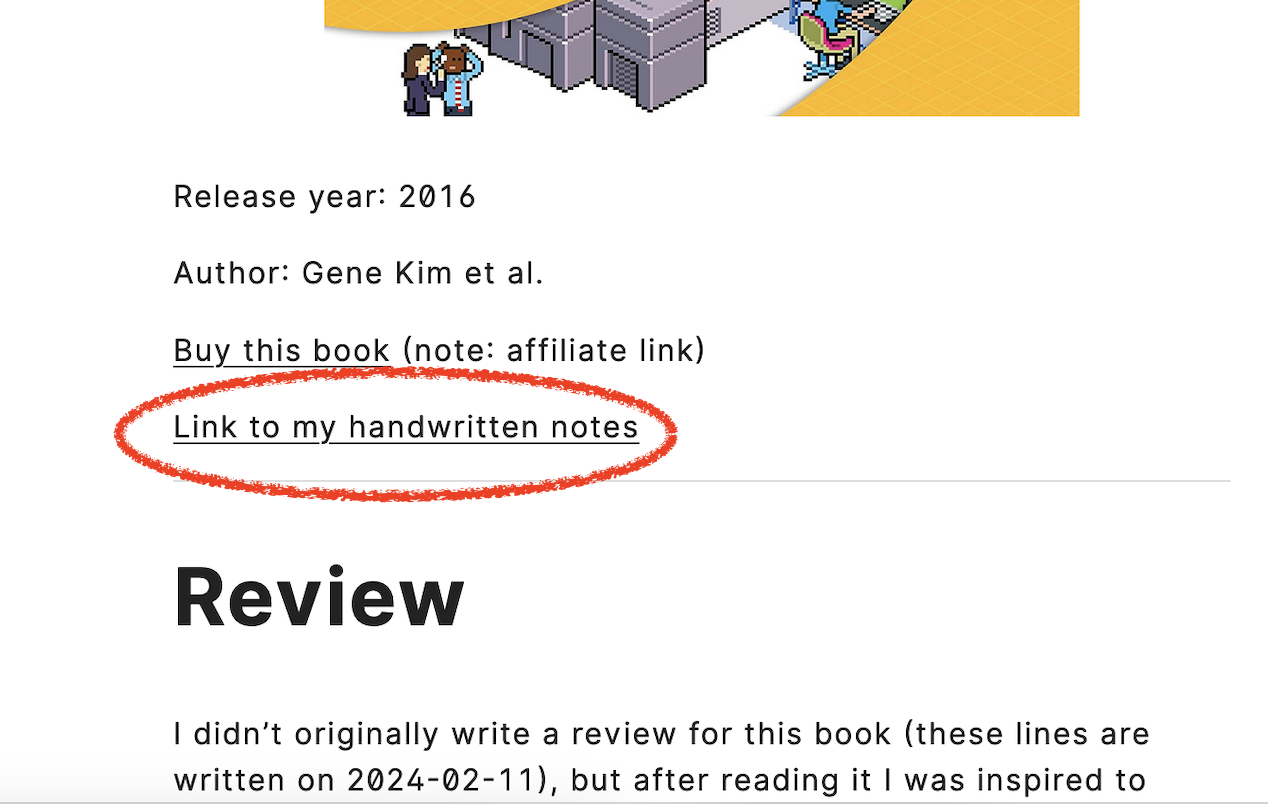
If you are looking for a flatbed scanner, the one I’m currently using is the Canon LiDE 400 and I am totally satisfied with it. Recommended!
A nice side effect of posting your reviews on a website is that you can implement custom visualizations. For example, I have a virtual bookshelf that I can use to retrieve my notes and even share them with interested parties.
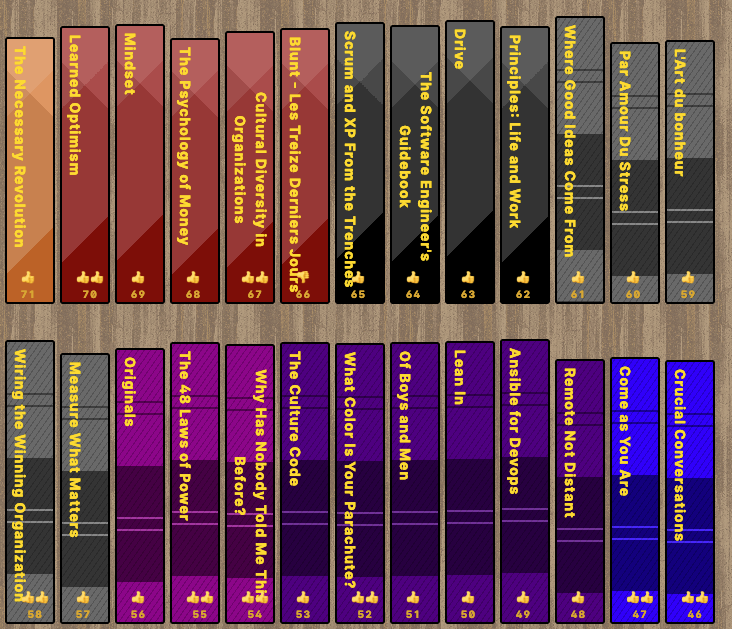
Ultimately, the format you use to review your books doesn’t matter. It can be a website like me, a fresh page in your notebook, a Word document, an email, a spreadsheet, etc. If you use your words to write about the subject you read about, you will do fine. The easier it is for you to access that information once you’re done, the better.
That’s it, really! However, since I am very passionate about this subject, I can’t resist sharing some additional ideas. Head over to the Appendix for more precise tricks.
Chapter 7: What I Learned
The ability to learn faster than your competitors may be the only sustainable competitive advantage.
– Peter Senge, The Fifth Discipline
Armed with my learning system, I became empowered to read any book I wanted. I discovered a world of knowledge that was inaccessible to me before. In this chapter, I will give specific examples of how I was able to apply in the real world what I learned from specific books and how this made a difference in my life and the life of those around me. I read all of these books between 2022 and 2023.
The DevOps Handbook: How to learn from mistakes as a group

Obviously, we have to begin with the Handbook that initially gave me so much trouble. From this book, I learned so many things, but if I could highlight a specific technique that I lifted straight from the book, it would be the Blameless Postmortem. This is a type of meeting in which a team analyzes the error that led to an incident, and what can be learned from it.
This type of meeting is initially difficult to get used to for a team unfamiliar with the concept, so having read the DevOps Handbook gave me the required confidence boost to not get discouraged when first attempts at doing postmortems did not go as planned. I developed the habit of telling attendees, “the only thing that matters is that we are learning, and that includes learning how to conduct a blameless postmortem.” In fact, whenever something goes wrong in my household, I now use the same ideas. Instead of getting angry at whoever committed the mistake, I ask myself, “What made them think they were doing the right thing when they were doing the wrong thing?” This allows me to learn faster from my own mistakes.
After two years of hosting this type of meeting in the context of incidents, I developed a blameless postmortem recipe that I can now bring with me everywhere I go.
Continuous Delivery: Using links in notes and in writing

This is another DevOps-centric book, but the most useful thing I learned from it was, surprisingly, how to handle links in a book. This is where I got the inspiration to use URL shorteners in my notes and in my writings. In this book, instead of pointing to a long link in the references section, every link appears directly in the text next to where it is most useful, in the form of a bit.ly shortcode. That is so convenient! I couldn’t resist imitating this idea. I have never seen any other book that does this, except the one you are holding in your hands right now.
If you’re curious about the inner workings of short codes, see Appendix A.15.
Radical Candor: Giving and receiving feedback

This book taught me how to receive criticism gracefully, and how to provide feedback to someone.
I have always had a thin skin when it came to feedback. I would often live for compliments and get slain by any criticism. This changed when I read this book. For example, I feel more confident in showing my work to the public because I am less afraid to be faced with criticism. I trust that I have the right tools to handle it. This is why in the preface of this book I felt comfortable asking for your feedback if you found any part boring.
Another example is when I have to give tough feedback to someone. I am still getting used to this process, and I don’t want to divulge any example here in case this would get into someone’s privacy. Let’s just say that this allowed me to deepen my relationships with my colleagues and build trust more quickly, since we felt like we could really trust each other’s feedback.
How to Win Friends and Influence People: Listening to the person in front of me

This book taught me how to shut up and listen when people talk to me. I used to feel so insecure about how I was being seen by other people that I would always try to fill every room I was in. Not only was this surely annoying to the people around me, but it also distanced me from them. I was not open to learning about them.
After reading this book, I started listening and being more interested about what people around me had to say. It surprised me how quickly we could dive into rich, difficult topics that we don’t hear a lot about in casual conversation: how one feels about their gender transition, how racism affected one’s life and family, mental health issues, thoughts of suicide… The skills I learned from this book made me feel closer than ever to my loved ones and allowed me to reinvent my social life.
Psycho-Cybernetics: Separating mental image from physical appearance

This book allowed me to have real conversations with my partner about physical appearance. My partner is a beautiful, beautiful woman who sets the bar really high for herself. In the past, I didn’t know how to deal with insecurities related to physical appearance. This book taught me the concept of the mental image, and it has been a useful concept to relate to what my partner was feeling and to express to her how I felt about her appearance.
Ever since reading and discussing this book with my partner, I feel like we are more equipped to discuss these parts of ourselves that we don’t like. The concept of the mental image helped us draw a line between how we perceive ourselves and how others perceive us. Both in the case of physical or mental defects, our level of inner peace has greatly benefited from this read.
Atomic Habits: Working out regularly

This is a book about developing good habits. I had known for a while that our life is approximately the sum of our habits, and I knew that my habits were mostly bad, yet I didn’t know how to change them. One habit I most wanted to build into my life was doing more physical activity. Diabetes (type 2) runs in my family, and I knew I was on a slippery slope myself.
This book gave me tips that allowed me to chain my few good habits together in a way that would empower me to add new ones. For example, I love the feeling of taking a shower after shaving. Thus, whenever I work out, my reward is to shave before taking a shower. It’s a stupid thing, really, but thanks to that, I have done 76 workouts between December 2023 and July 2024, and I don’t plan on stopping. I average 2.7 workouts per week and it doesn’t feel like a chore.
Words can’t express the satisfaction of seeing my muscles in the mirror for the first time!
Also, I learned how to get rid of bad habits by making them harder to do. I reduced my alcohol consumption and now eat way less sugar than I used to simply because I decided that I will not buy sweets and bring them into my home.
Crucial Conversations: Discussing sensitive issues without losing control of emotions

This book probably saved my relationship with my partner in the rare moments when we’ve had disagreements. Before getting familiar with concepts like the Path to Action, I always found my emotions getting the best of me in important conversations and then regretting it later. This book made me understand that it is foolish to believe we have to choose between telling the truth and keeping a friend. We can do both.
My partner is an expert negotiator and I always felt like I couldn’t keep up with her when the time came to make important decisions. After reading Crucial Conversations, I could respectfully stand my ground.
Remote Not Distant: Making people want to come back to the office

In the post-pandemic hybrid workplace, this book taught me that the office is the new offsite. This means that what used to be a big team bonding event, e.g. spending a couple nights at a cottage as a team, is now replaced by simply going to the office. This means that if an office contains nothing that cannot be done from home, no one will come to it. This reduces the possibilities of serendipitous connections, and parallel communications.
These concepts gave me ideas about how to contribute to making the office where I work fun, engaging, and also special. I set up an arcade that colleagues can play for high scores. I brought puzzles to our kitchen to have people collaborate together. These are little things, but they are working, because I often hear “I’ll have to come back to play some more.”
Ansible for DevOps: Getting through probation on the first try!

This is a book I had to read in haste before I started my new job at Portage Cybertech, since Ansible is a tool I was not familiar with. My learning system allowed me to power through the book and become productive on day one.
I cannot say that my code design was anything fancy (I should have probably read Clean Architecture: A Craftsman’s Guide to Software Structure and Design for that), but at least it helped me to pass my probation in flying colours this time around.
Conclusion
One day, the mountain that was in front of you will be so far behind you, it will barely be visible in the distance. But who you will become in learning to climb it will stay with you forever.
– Brianna Wiest, The Mountain Is You
I find the next image very telling. What it shows is how my learning system allowed me to compress a 421-page book down to its essential learning nuggets, which take only 50 handwritten pages in my A5-sized journal. This means I will get as much information from reading these 50 pages as from reading 421 pages.
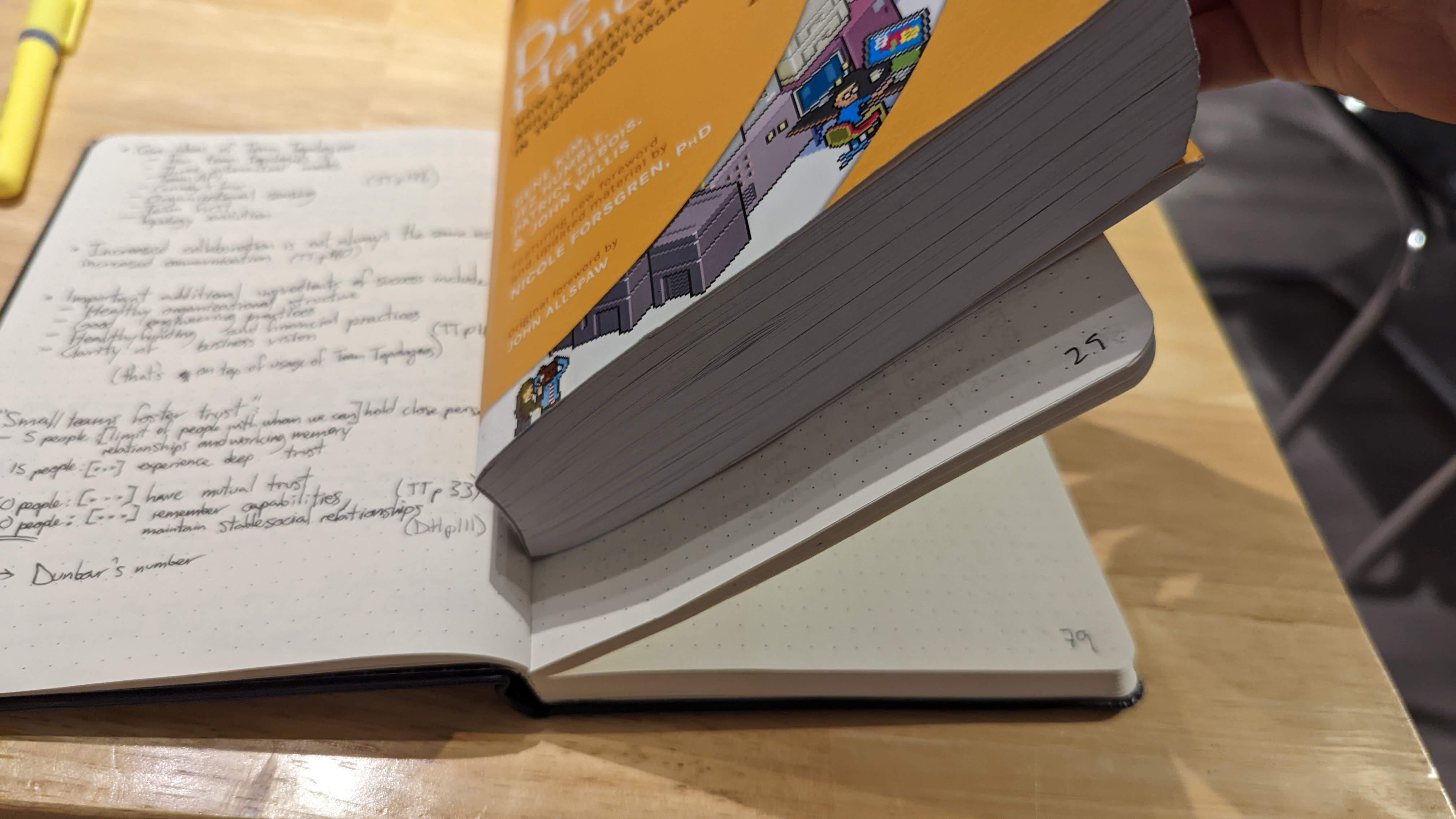
Instead of taking days to review that information, it will take me one hour. This feels almost like cheating, except it isn’t! I worked hard for this outcome, and now I get to savour it. Better yet, since all the crucial information is compact and written by me and for me, the ideas get organized in my head much quicker than if I was just reading the book all over again. The information has been pre-digested.
Books are not something to be afraid of. Not anymore. I realized I now get to decide which book I read. As a professional, I am the master of my own learning. This ability to learn allowed me to find quotes that I now live by and that guide all my decisions.
What is learning, at the end of the day? According to Steven L. McShane (Organizational Behavior), it is “a relatively permanent change in behavior that results from the acquisition of skills.” When we start making different choices, we have learned.
Textbooks have a purpose outside the classroom, even if that means you won’t have a professor dragging you through it. Not all textbooks feature exercises and homework; some can be quite fun, relaxing and enlightening to read, without creating headaches or feeling like puzzles. A book you chose almost certainly contains elements of the answer to the question that made you choose it.
So, what will you choose as your next book? Will it be about psychology? Technology? Cooking? Management? Leadership? History? The choice is absolutely yours!
I can’t describe how awesome it feels to find a book that shows me a new way to think about a specific problem that I couldn’t quite figure out. Suddenly, a new connection occurs in the brain. Everything simply makes sense! Personally, this is among the most powerful and freeing experiences I have felt to date. It truly is a transcending moment that cannot be overstated. In the beginning, reading to learn felt painful. Now, I’m addicted.
We are all lifelong learners. If you want to learn about something, you can do it. What allows some people to learn faster than others is that they have created and optimized a learning system suited for their way of learning. When I realized that the core mission of DevOps, which eluded me for years, is to create a system that automates organizational learning, I felt a pinch of irony since this realization had required me to create my own system of learning. Now that I’ve done it, I feel more empowered than ever and ready to take this challenge of automating organizational learning head-on. Writing this book is part of that effort.
I don’t want to give you the wrong impression: I am still not immune to learning anxiety, even after reading 105 books and writing all about my experience. Nobody gets used to feeling dumb, and unfortunately the more you learn, the more you realize how little you know about anything. The good news is that I now feel equipped to tackle this journey. I’ll never be done learning, and true learning is always an uncomfortable, if not painful process. Nevertheless, my learning system allowed me to come across pieces of wisdom that radically changed my relationships and my life for the better. I cannot even begin to express the sheer magnitude that the ability to read non-fiction books had on my life. I do not feel crippling anxiety when I step into the office every morning. I do not feel afraid to give my opinion on important topics. I do not feel threatened when I disagree with people I love. In fact, now more than ever, when I speak to friends and colleagues, I feel valued and genuinely interesting.
Still, I am overcoming learning anxiety. I’m not done, and probably never will be. I’m learning that pain can be leveraged. I’m starting to believe that the only real failure is not to learn from failure. I’m beginning to see fear as a compass that guides us toward the path that will make us grow. I’m still scared of exams, and I honestly still fear getting fired from time to time! Some things are unfortunately part of life. What I learned is that by arming ourselves with knowledge, our problems become more interesting, more fulfilling, and closer to our true ambitions.
If you personally suffer from learning anxiety and made it this far in this text, I am in awe of you. You are among the courageous few that made it to the end. Seriously, lift your favourite arm and give yourself a pat on the back from me. I’m confident that you are already on the right path: the real journey begins here, if you accept it. I hope the ideas I have outlined above will inspire you to give them a try or, better yet, to find your own system and rediscover the simple, sacred joy of learning. If this changes your life even half as much as it changed mine, you, my friend, are in for the ride of a lifetime.
We truly can do anything we set our mind to. That is what learning is all about.
Your move!
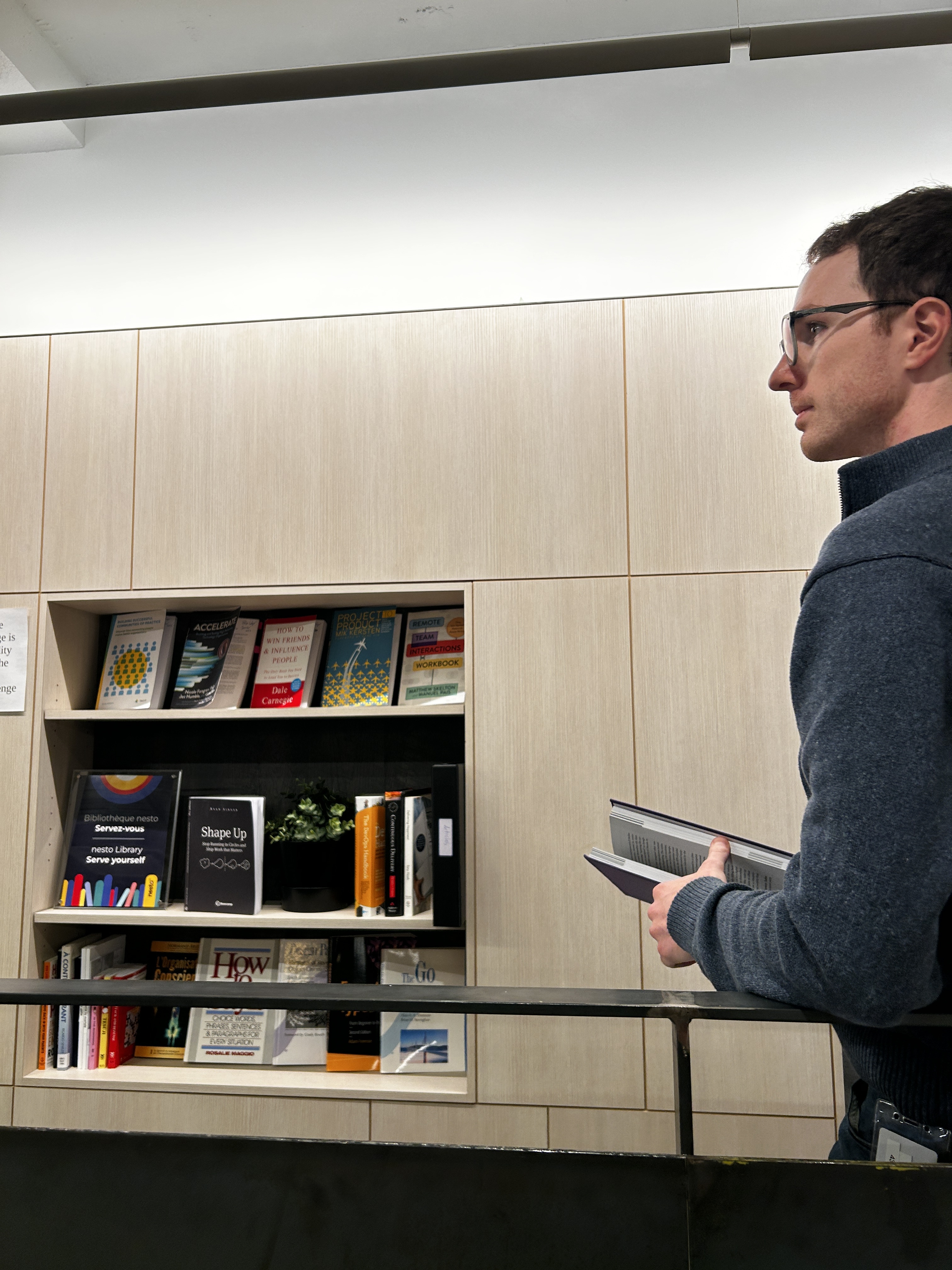
Appendix A: Additional ideas
In this section, I will tell you about some tricks I picked up over years of learning from books. Think of them as suggestions that might be worth exploring. We’re all unique and we all learn differently, so it’s perfectly fine if what works for me doesn’t quite work for you.
If you have other interesting tricks you would like to share, please let me know.
A quick recap of the main method
Here’s a summary of the method shown in chapter 6:
- Read and highlight the golden nuggets.
- Write down your highlights.
- Find your Star Quotes.
- Write down your opinion of the book.
Idea 1: Have a goal
Writing goals down makes them real.
John Doerr, Measure What Matters
Having goals gives us momentum. Why do you want to learn about something? Try to make this obvious to yourself.
When I began my learning journey, my goal was to save my DevOps job at nesto. Having this clear goal in my mind made it easier for me to focus on searching for solutions that would nudge me closer to my goal. Finishing The DevOps Handbook seemed like a reasonable objective in alignment with this initial goal.
What is important is not whether you succeed at your goal or not. In fact, it can be good to fail at reaching an important goal, as long as you see this as an opportunity to learn about what you could improve next time around. The reason it’s important to set clear goals is so that before we try something, we can verify if it’s pushing us in the right direction. It doesn’t have to be a big goal. It just needs to be meaningful to you and push you in the right direction. You can make the goal bigger as you get better.
If you are looking for a suggestion, here’s mine. Every day, before going to sleep, read 5 pages of a book until you finish it, following the method outlined in Chapter 6.
Idea 2: Read non-fiction
Everyone loves a good story. There is indeed value in reading a well-constructed fiction. Some of my fondest memories include reading Harry Potter and talking about it with my father. However, I believe the lessons learned from fiction will be acquired slower than from reading non-fiction, partly because fiction is, well… not real.
I would suggest you give non-fiction a try if you have not done so already. By non-fiction, I mean a book that discusses a subject anchored in reality. It can be a history book, a book focused on a specific topic, or even a biography. Non-fiction books are generally not boring: they are also filled with stories. What’s convenient in non-fiction is that the stories told really happened. Thus, the lessons one can learn from them are much more obvious. There is less interpretation to be made making them more directly applicable in one’s life.
Idea 3: Never go out without a book, a highlighter and a pen
Personally, I feel naked whenever I go somewhere without my book, my notebook, my pen and my highlighter.
It’s impossible to make progress in a book you don’t have access to. One can’t highlight golden nuggets without a highlighter in hand. If you want to get serious about your reading habits, you need to find a way to always have these objects available. The closer they are to your hands, the better.
It doesn’t have to be complicated. If you travel with a bag, that’s an obvious spot to store your books. If you have pockets, that’s an obvious place for a pen and highlighter. Truth be told, you don’t really need a bag or pockets to make this idea work. You could simply keep your book and highlighter in your hands and your pen behind your ear for the few times you might need it. No clothes required!
If you are dying for a bag recommendation, here's the bag I use when I'm traveling. It’s light, compact when stored, and gets the job done every time.
Idea 4: Grab your book before grabbing your phone
In my experience, the best way to progress through a book is not to allocate long periods of time for reading, but rather to keep your book handy at all times (see Idea #3) and to open it whenever you’re between tasks. When I get people to pick up reading again, their intuitive response is generally to say, “I’ll set an hour aside in my calendar for reading.” And they do. And then nothing else happens. They are still unable to turn reading into a habit!
Do you want to know a dirty secret? I have trouble reading for more than 30 minutes at a time. I doubt most people who schedule to read a full uninterrupted hour succeed. In my opinion, they mostly end up fooling themselves.
Fortunately, I bring good news. I have found the perfect solution to instantly bake reading into your routine. But you must stick to it, otherwise it will not work. Ready? Here it is:
Any time you feel like picking up your phone to browse, pick up your book first, and see if you can read a paragraph or two (or more, if you get into it!) before using your phone.
In other words, earn the right to use your phone by first reading two paragraphs from your book.
How was that? Disappointing, right? Well, too bad, that really is the secret sauce to finishing books quickly! 😃
If you try it, I’m certain you’ll be amazed by the results. Most of us are addicted to our phones, and this idea turns our addiction into something positive. Change your phone’s wallpaper to remind you to read if you need to. After some time, if you’re anything like me, you might come to prefer reading your book than using your phone. Indeed, why waste time searching for inconsequential content online when the content you really care about is right there in your book?
Caveat: For this idea to work, you must have your book and your highlighter on you (see again Idea #3) pretty much all the time. It’s worth it!
Idea 4.1: Buy an alarm clock and leave your phone out of the bedroom
Kudos to Simon Sinek for this idea. Most people keep their phones next to their bed because it serves as their morning alarm clock. That’s a terrible practice, for we know how damaging it is for our eyes and minds to use our phones before going to sleep. Try adopting a different strategy that generations of people before you have relied on to go to sleep: get yourself an alarm clock (here's the one I use), move your phone’s charger out of your bedroom, and bring your book to bed instead. Not only will this make you read more, but it will also make your sleep better.
Idea 5: Use a red LED headlamp to read in the dark
I find it convenient to not depend on a light fixture to read. I keep a head lamp next to my bed to read a few pages before going to sleep. It’s simply more convenient and comfortable that other alternatives.
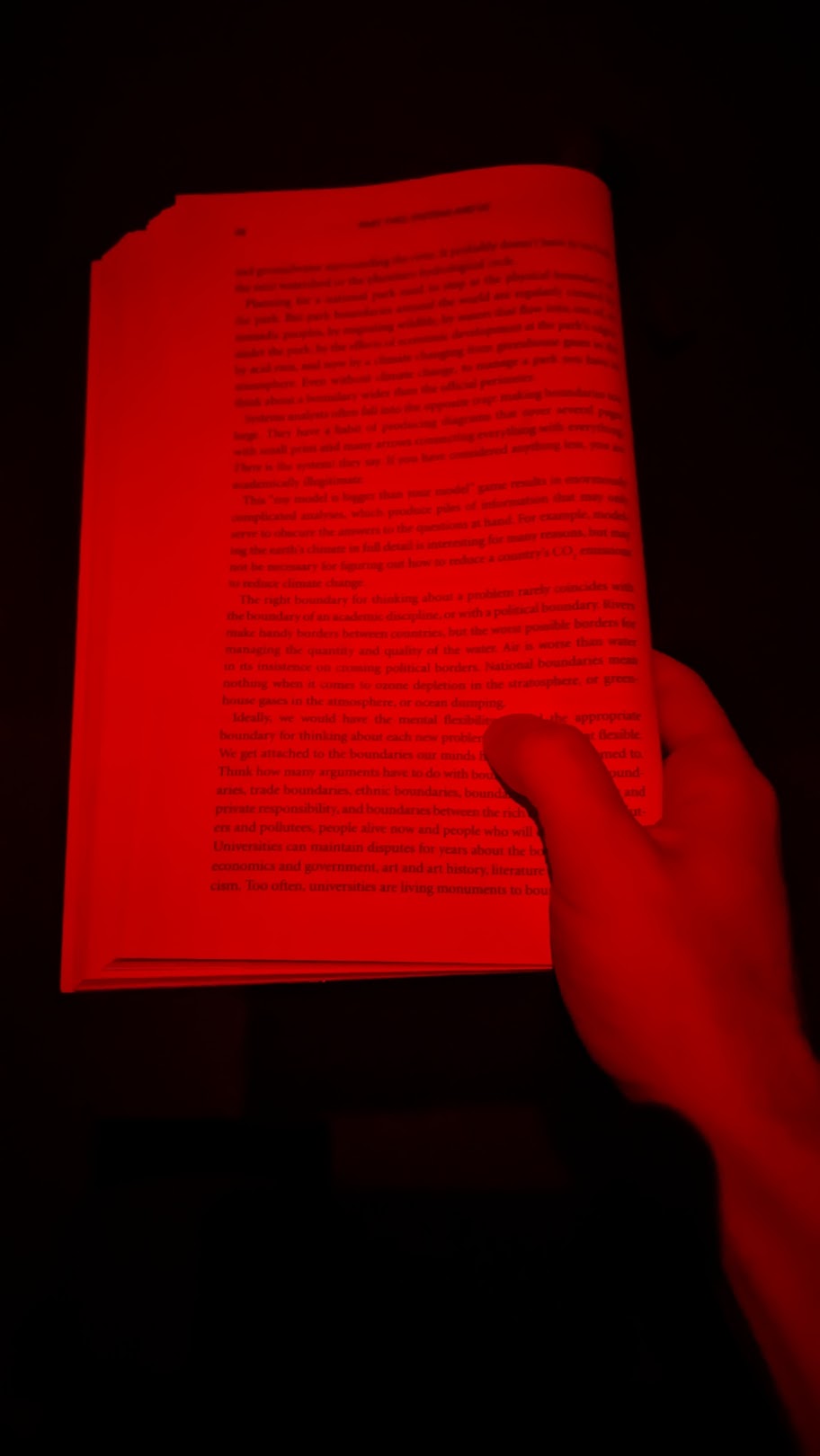
The model I am currently using is the Black Diamond Cosmo-R, but for our needs this might be a bit overkill. I suggest you simply look for whatever headlamp that has a red LED that can be set to low levels of intensity.

Idea 6: Start by reading a single book at a time
As you start learning, you get excited when you see all the possibilities within your grasp. Here is a quote from The DevOps Handbook that I constantly need to remind myself:
Stop starting, start finishing.
Generally, for better or for worse, the end of the book is often when everything comes together and the author “blows your mind.” Choose your book carefully and do your best not to start another one before you’ve finished your current one. Use this as motivation to get through your current book, if needed!
Personally, shelving a book without finishing it only leaves me more confused. It gives me some pieces of the puzzle, but since I lack the remaining pieces, I will never see that puzzle to completion. Bite the bullet and finish the books you start, unless they are novels that fail to grab your attention.
You might want to wait until you’re in the final pages of a book before ordering your next one. You don’t want to make commitments that you might not be able to keep! I strongly advise purchasing only a single book at a time, especially at the start of your learning journey - try not to get carried away!
Idea 7: Track your progress by folding the corners
Each page has two corners and I use this to my full advantage. The top corner indicates my reading progress, and the bottom corner tracks my note-taking progress. No need for a bookmark and no risk of losing the page I was on.
I said it before, but I’ll say it once more: books are punching bags!
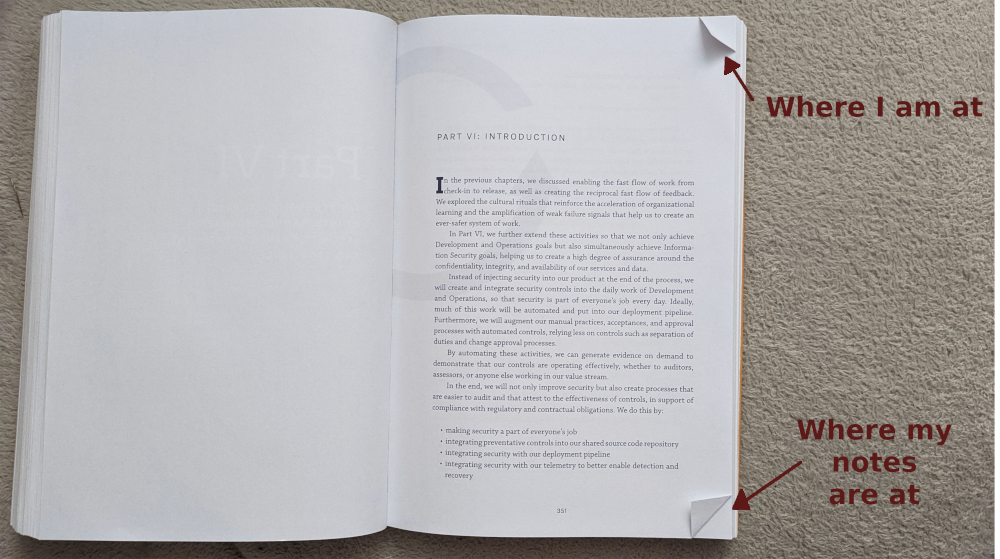
I can’t overstate how useful this is. It gives the feeling that no moment spent reading or taking notes is wasted. Whenever something else needs my attention, I simply fold the corner, fully aware that whenever I’ll come back to the book, I will know exactly what I was up to.
Here’s a bonus idea. On top of using the folded corners, I also leave a mark with my highlighter next to the sentence I was currently reading to clearly identify the spot I was at. This makes it immediately clear where to continue reading from. Thanks to this, I rarely have to read the same paragraph twice:
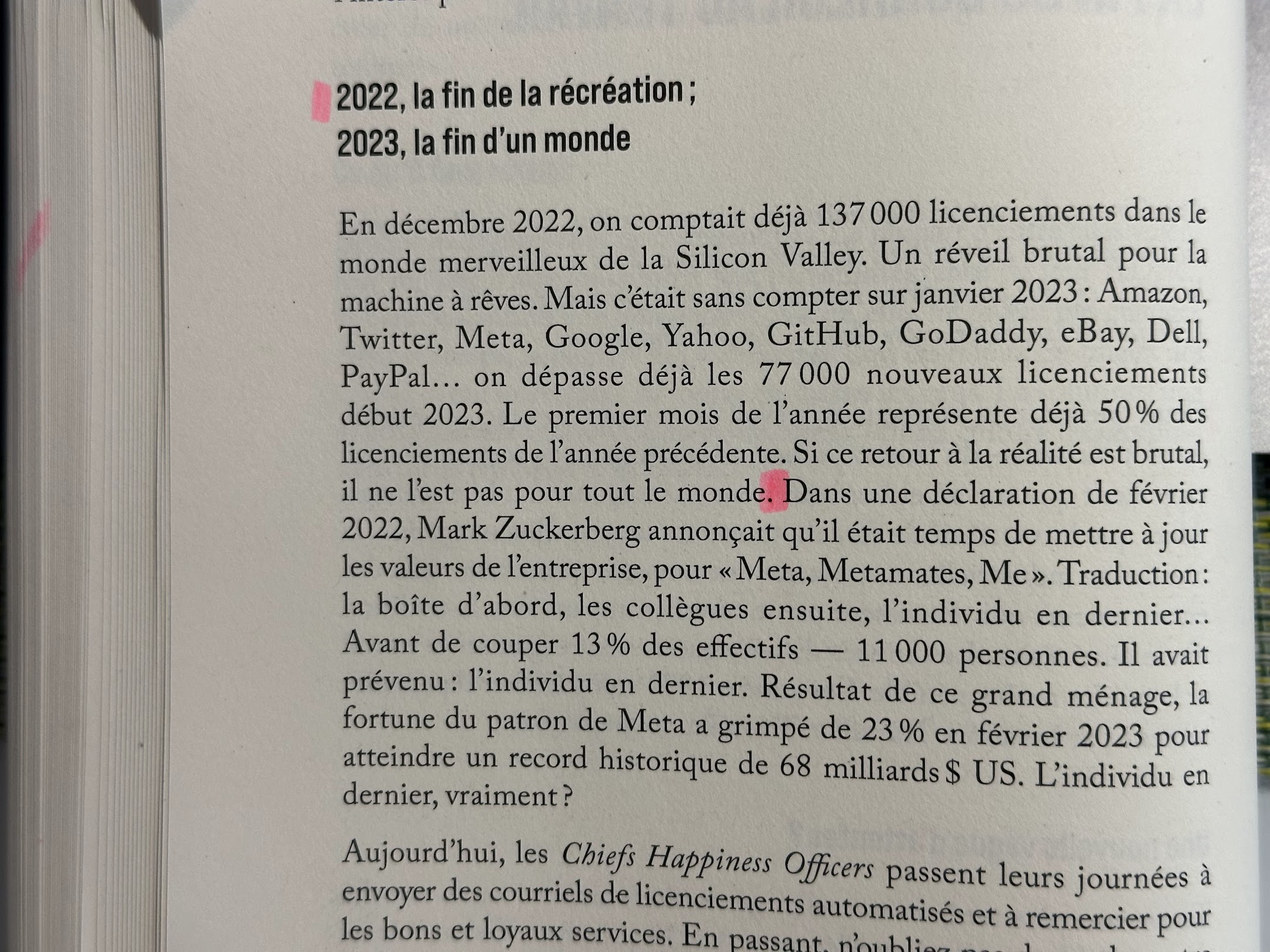
To summarize, I like the fact that each corner tracks different activities:
- reading
- writing (note-taking)
If I’m in the mood for reading, I read. If I’m in the mood for taking notes, I write. I feel like I’m free to choose which activity is right for what time. And, most importantly, whatever I end up choosing, I’m constantly learning.
Idea 8: Use the body of your highlighter as a visual aid
When I picture someone reading, I often see them using their finger to track their progress, like this:
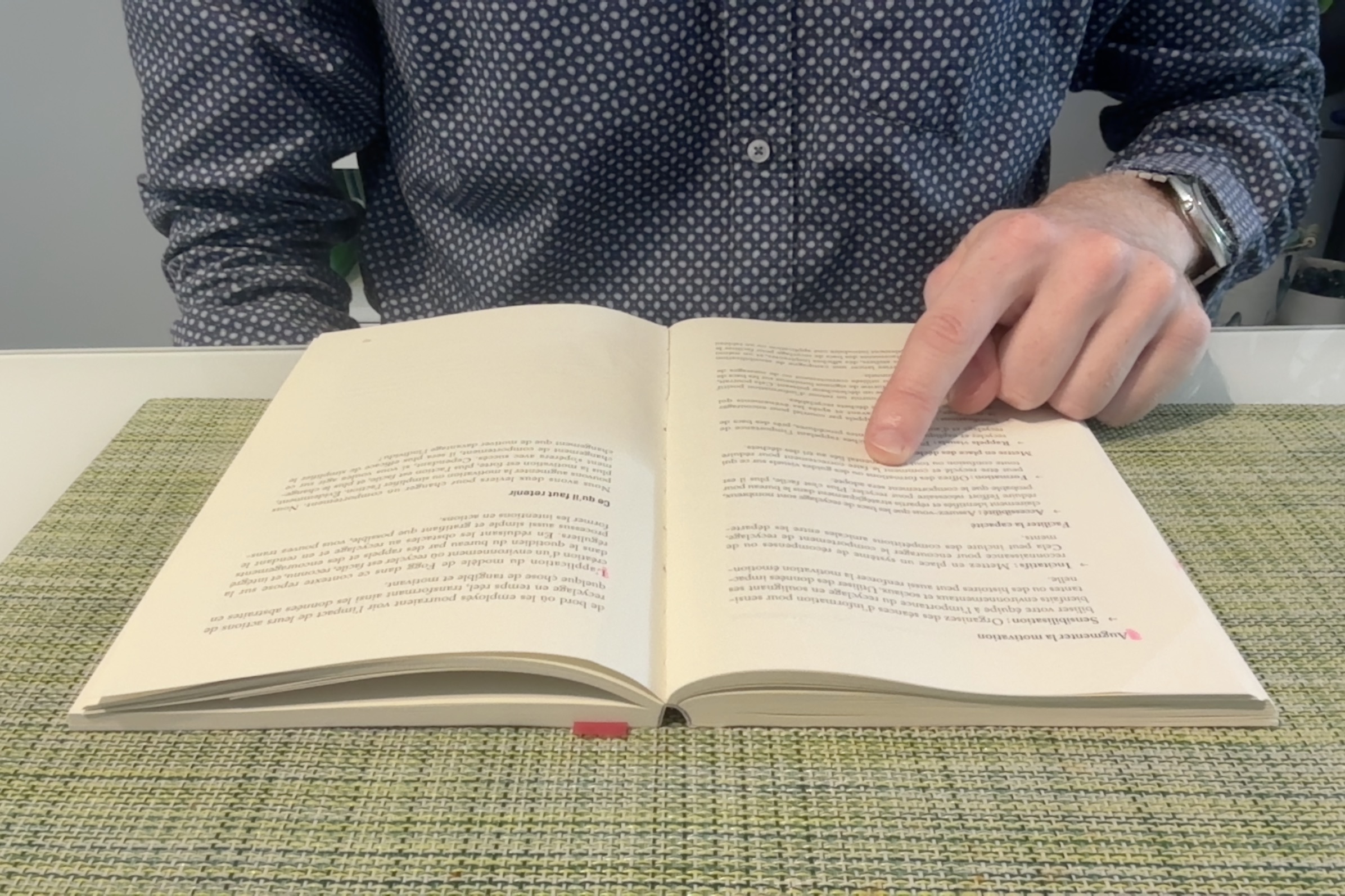
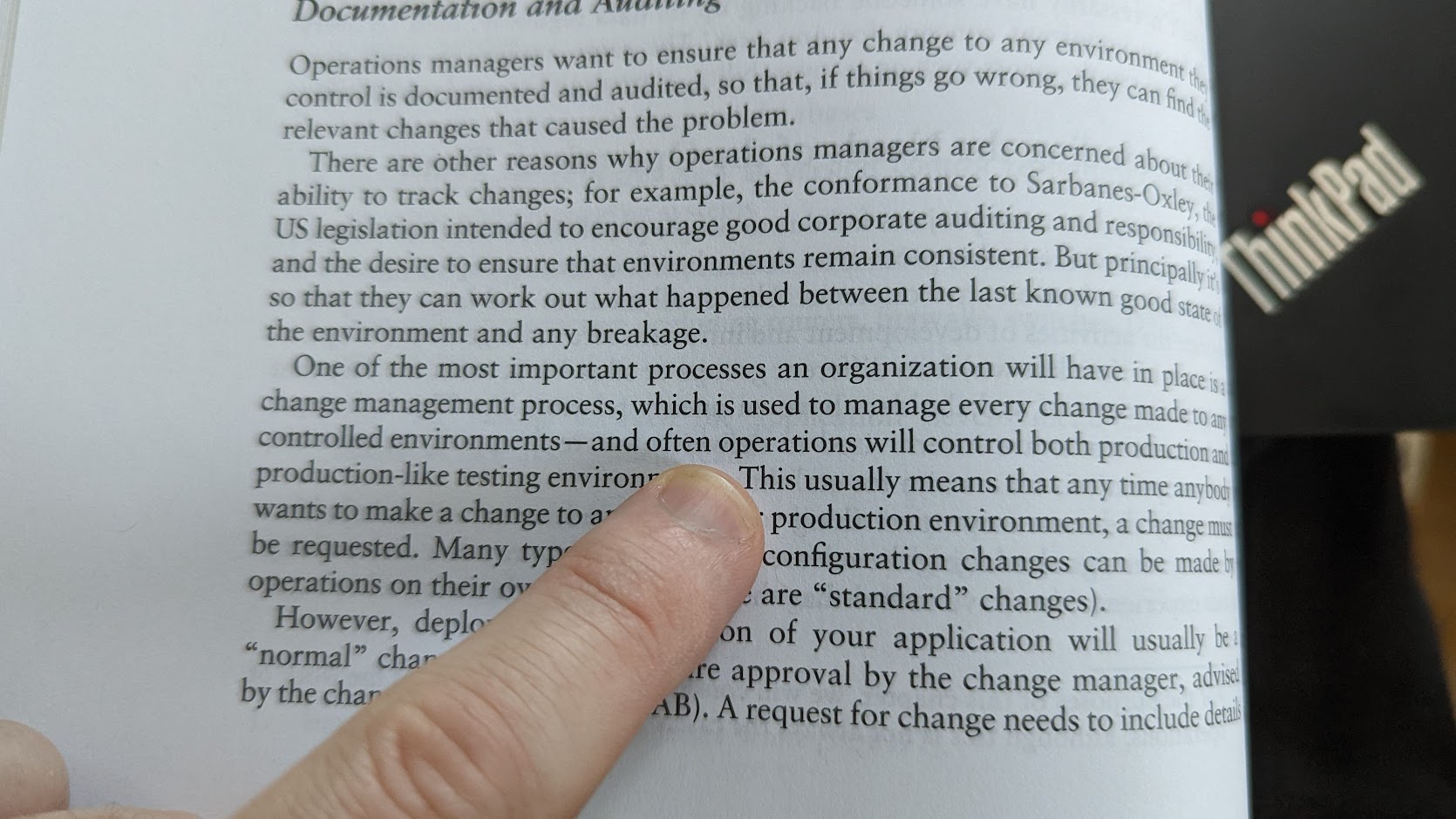
However, this method of tracking never felt right to me. There are many reasons:
- My finger is too big to accurately point to specific words on a page
- To reach the full width of the page with my finger, I have to move my entire arm back and forth as I read or move the arm holding the book. It wastes energy.
- I don’t particularly appreciate the friction of the page on the tip of my index finger, especially over extended periods of time.
The method I now use to guide my eyes as I read is to use the full body of my highlighter. Since my system is based on Matt Morris' learning strategy, I always have a highlighter in my hands when I read, so this puts it to good use.
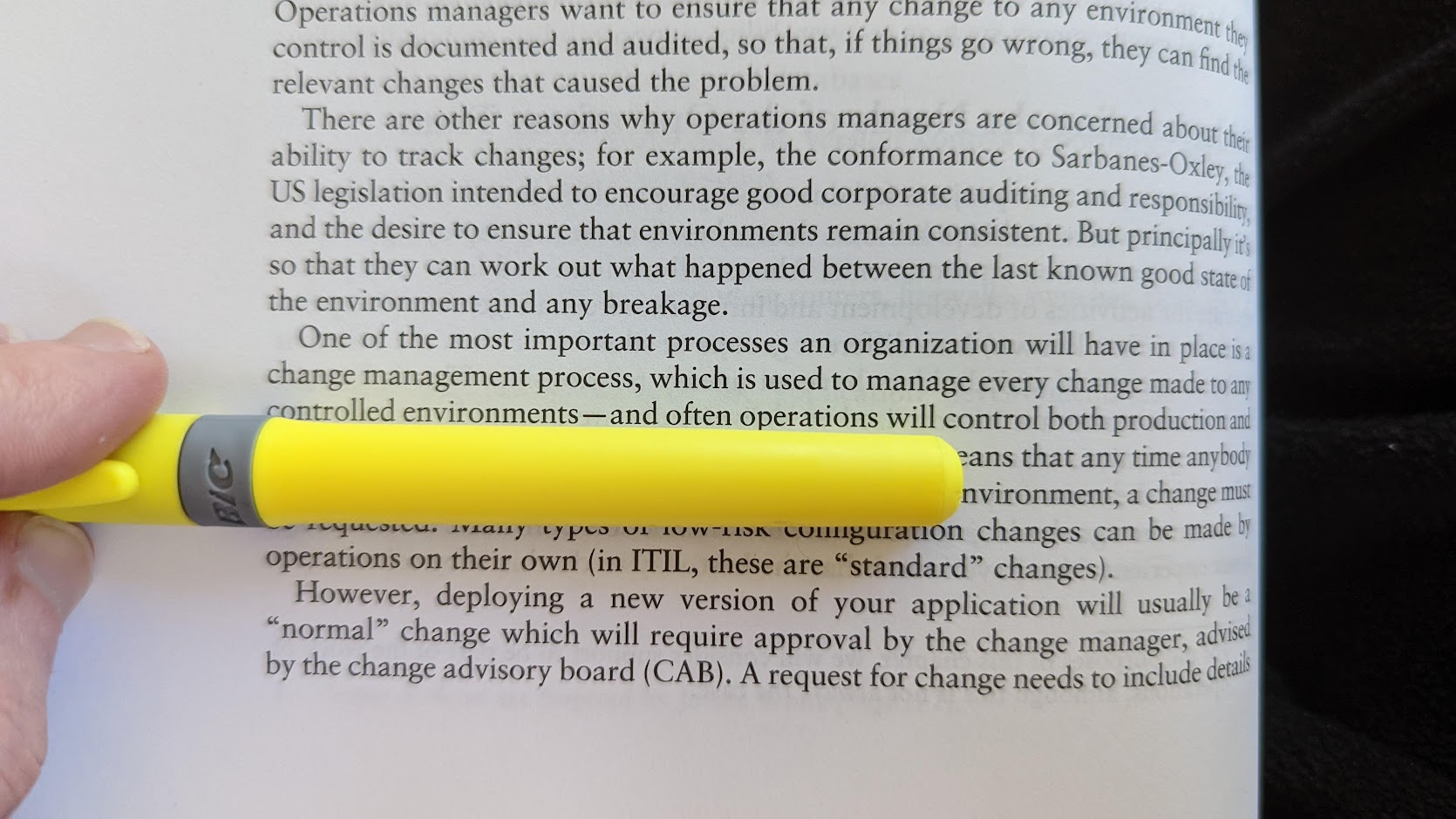
This has many benefits:
- Unlike the tip of your finger, the body of the highlighter is flat. It makes it obvious which line you are currently looking at.
- You can let your eyes glide along the body of the highlighter. It feels less jittery than following the movement of a finger which can only point to one word at a time.
- The body of the highlighter is:
- long enough to allow me to reach the full width of a page without having to move my wrist, let alone my arm.
- vivid in color, making it quite eye-catching.
- wide enough to hide the sentences below what I am reading, which ensures I am not reading diagonally.
Idea 9: Get the right grip
If you plan on reading for long periods of time, you need a way to get comfortable. Fortunately, I believe I have found an easy way that will work for most people. This is what it looks like:
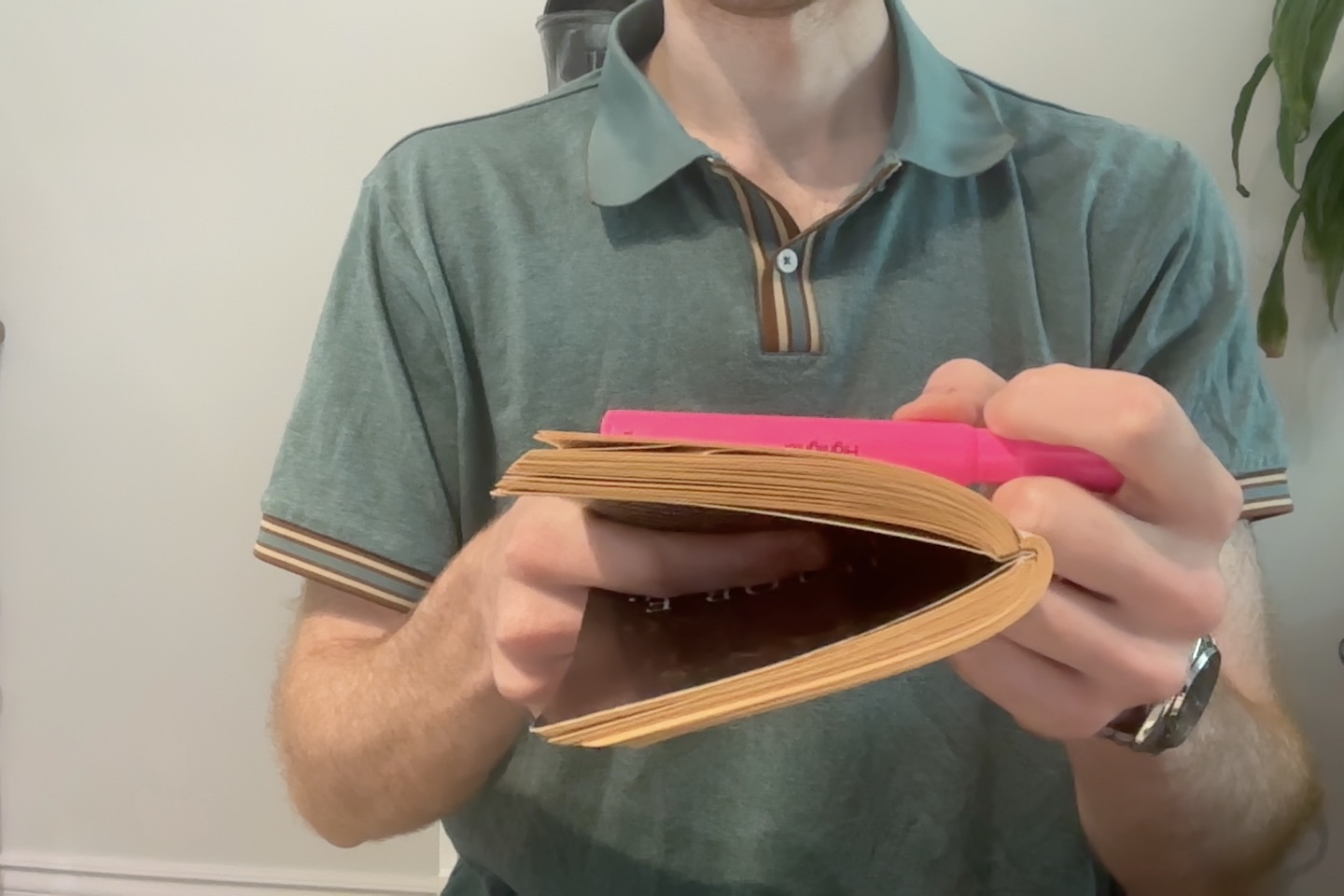
As you can see, one hand holds the book and the other holds the highlighter. I’ve already described in Idea #8 how to use your highlighter as a visual aid. Personally, I really like leaving my index finger between the front and back cover, because it creates a nice support without being in my eyes’ way. I hold the highlighter cap with my mouth whenever I need to make a highlight, that way I can keep a steady grip. When you reach the end of the page, simply switch hands!

Idea 10: Use creative highlighting to make note-taking easy
When we highlight in a book, we highlight for our future self who’ll turn these highlights into written notes. Our goal is to make that future self’s job as easy as possible.
Most of the time, there isn’t a lot of thought put into highlighting – that’s a good thing! If you find a sentence that you love, just highlight it. Easy peasy. But what if the useful information is split across different sentences? What if by switching some words around you can make its meaning more obvious to you?
Take the example below:
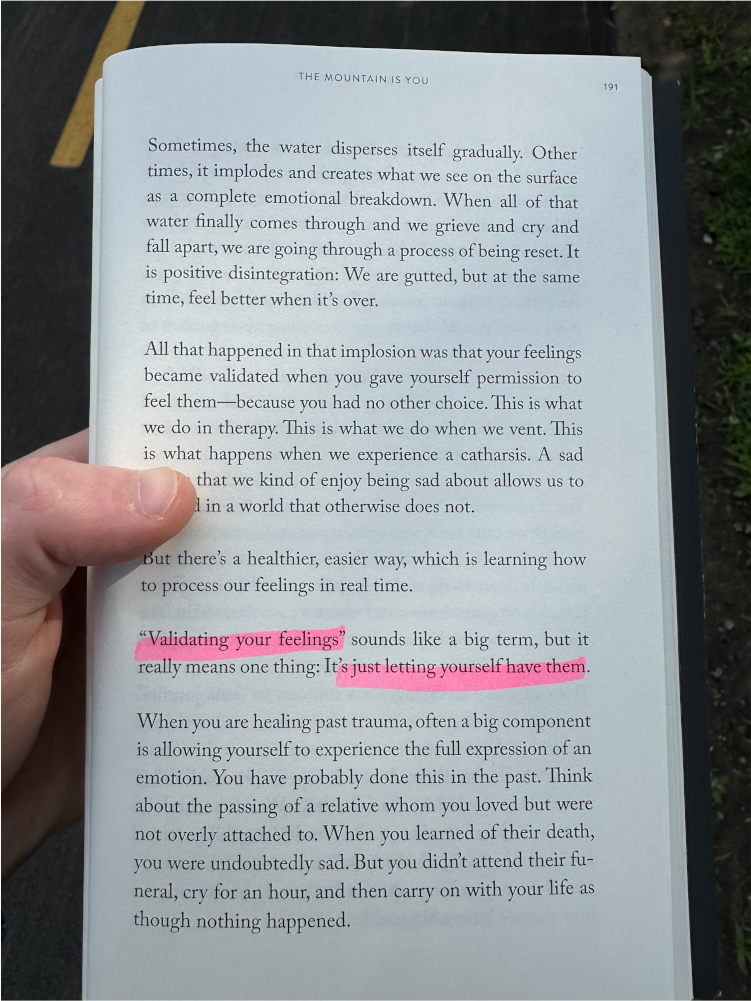
The original quote is:
“Validating your feelings” sounds like a big term, but it really means one thing: It’s just letting yourself have them.
I don’t need to remember that “‘Validating your feelings’ sounds like a big term that really means one thing.” What I want to remember is that validating your feelings is just letting yourself have them. And so that’s exactly what I highlight:
“Validating your feelings” […]’s just letting yourself have them.
This approach works a lot of the time, but there are some exceptions. For example, see what I did in the example below. It was simpler to simply write the missing bits with a pen instead of trying to reconstruct a quote using words already on the page.

This technique also works to trim the fat in a paragraph. See in the example below how I string together different sentences using a simple line.
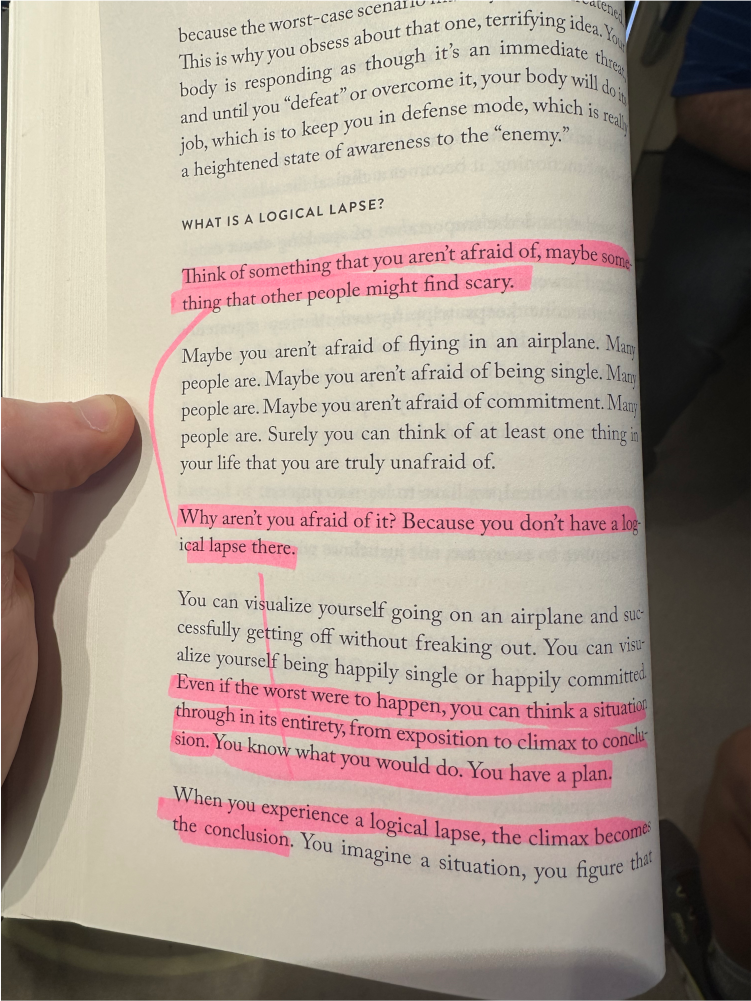
Finally, I noticed that some authors like to create enumerations in prose instead of in a list form. To help my future note-taking self, I use my pen to circle where each element of an enumeration begins in a paragraph. It makes the information much easier to parse later. It also signals that this information would be more visually striking if written as a list:
- First, …
- Second, …
- Finally, …

Idea 11: Use your book’s margins and blank pages to write ideas
If reading a certain paragraph triggers a light bulb in your mind or makes you pause and wonder about a specific question, I recommend that you write that thought in the margins next to the paragraph that inspired it. That way, when writing your notes, you will be able to revisit your own good ideas and decide how to expand upon them.
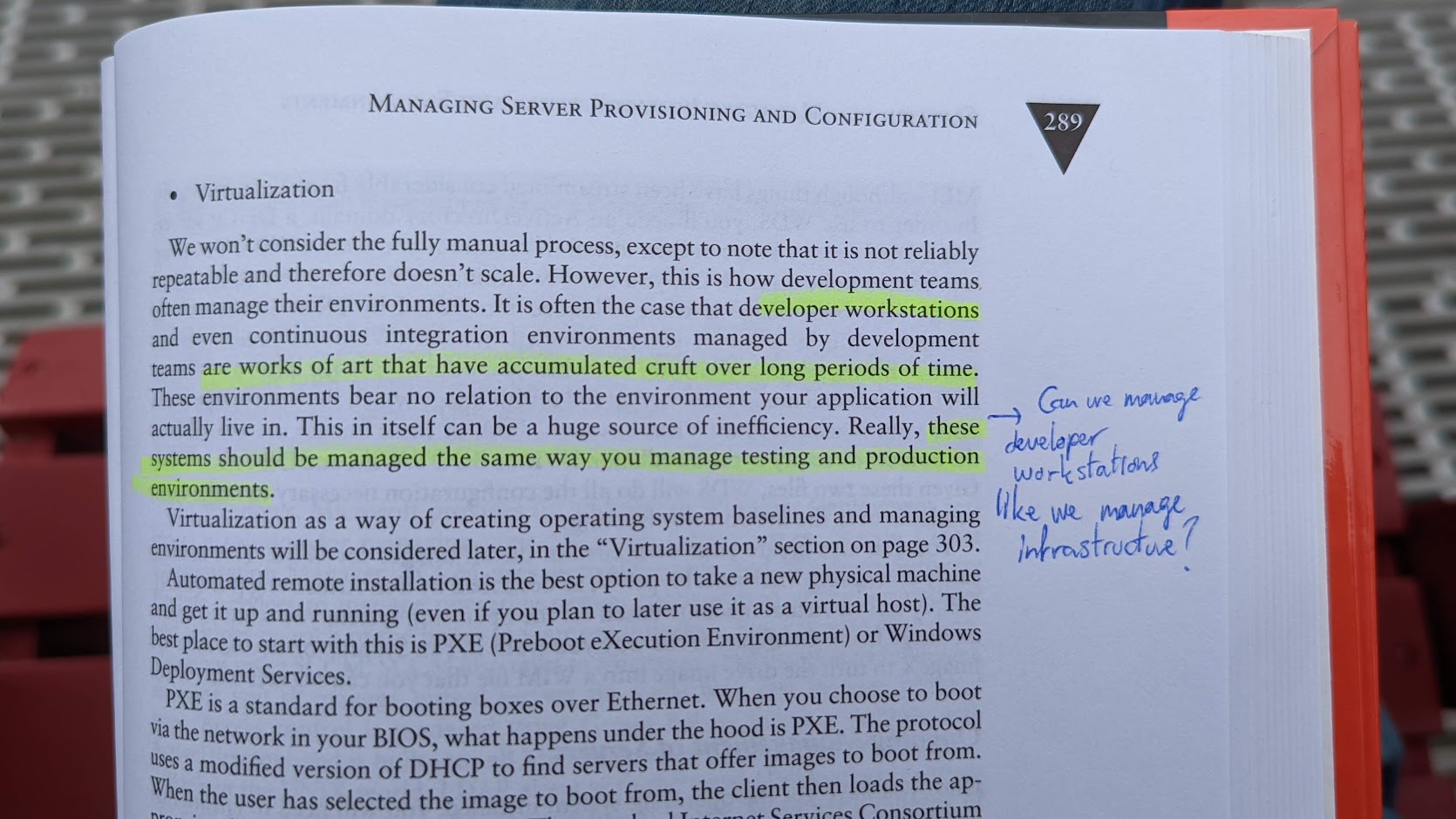
If you consider reviewing your book when you’re done with it (which I recommend!), you might want to write your impressions of the book near the front cover for ease of retrieval, as I have done in the picture below for the book The Mountain Is You.
Don’t let a good idea go to waste! 😄
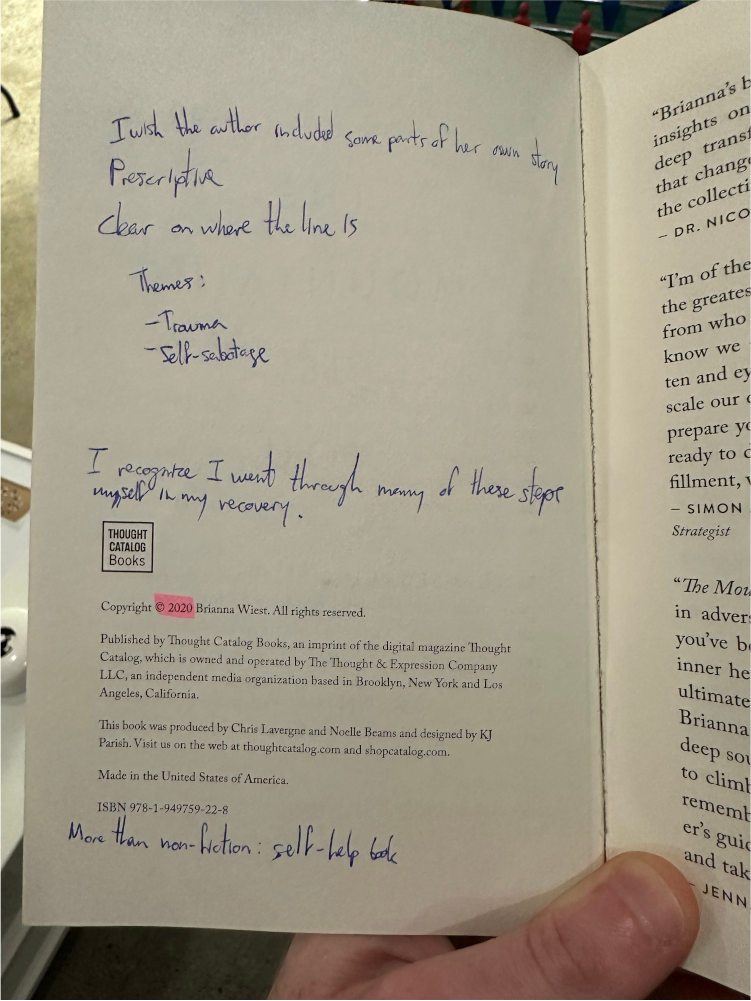
Idea 12: Number your notebook’s pages
If your notebook doesn’t have page numbers already (most don’t), I strongly recommend that you number your pages yourself. This is invaluable to allow you to reference your own notes later. This is a quality-of-life upgrade that is too obvious to live without.
If you have to number your notebook’s pages, take this opportunity to use a different ink color (e.g. red) than what you would use for your note-taking. Things will look much clearer when you reach the bottom right corner of odd-numbered pages. 😉
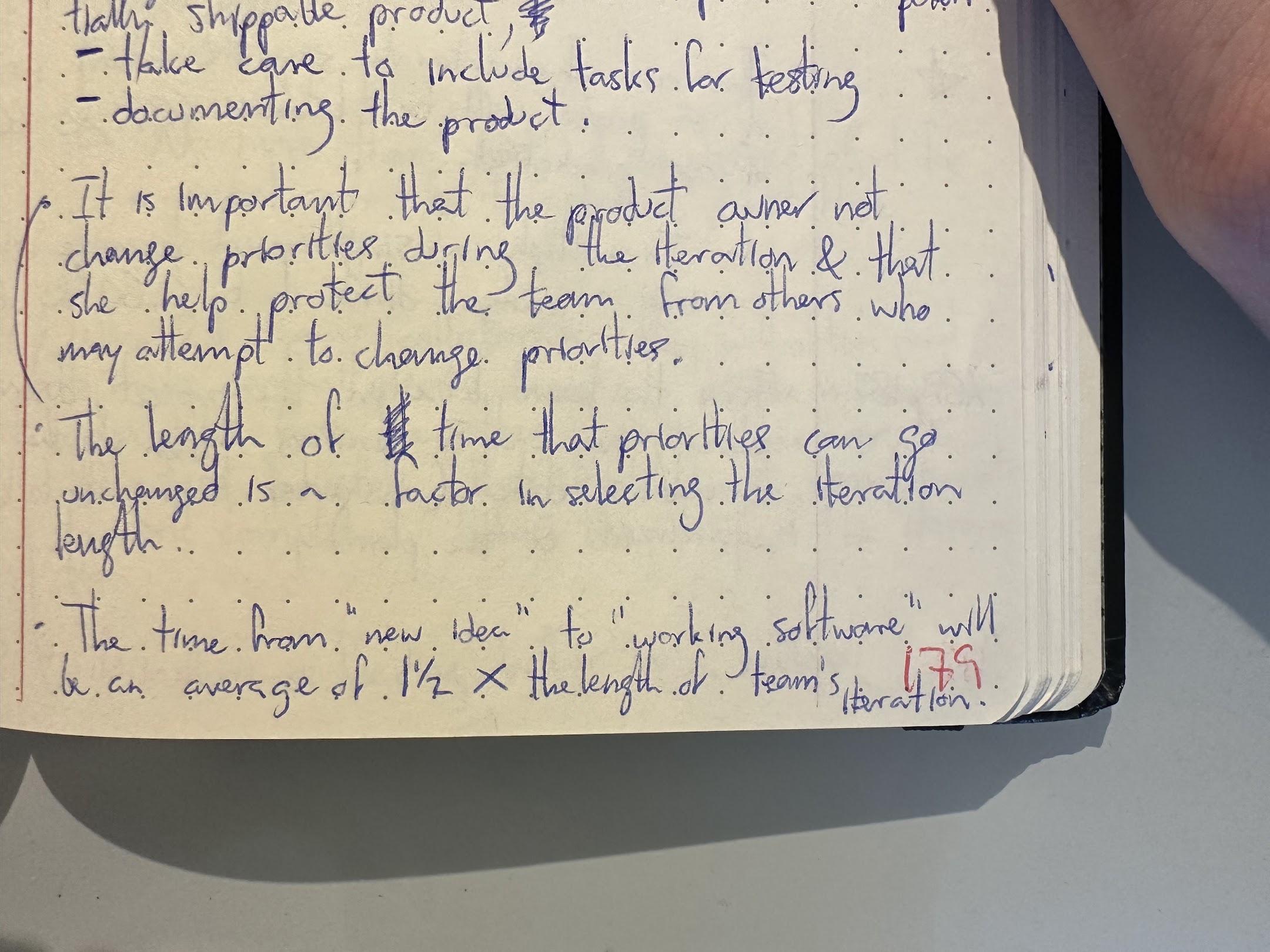
Idea 13: If your notebook doesn’t have margins, make some!
For most of my life, I assumed the margin was meant for graders to review your work and comment on their corrections. Well, news flash: the margin is for everybody!
It’s a shame that most quality notebooks that I know of don’t have margins. Use this to your advantage: make your margins as wide or as narrow as you need.
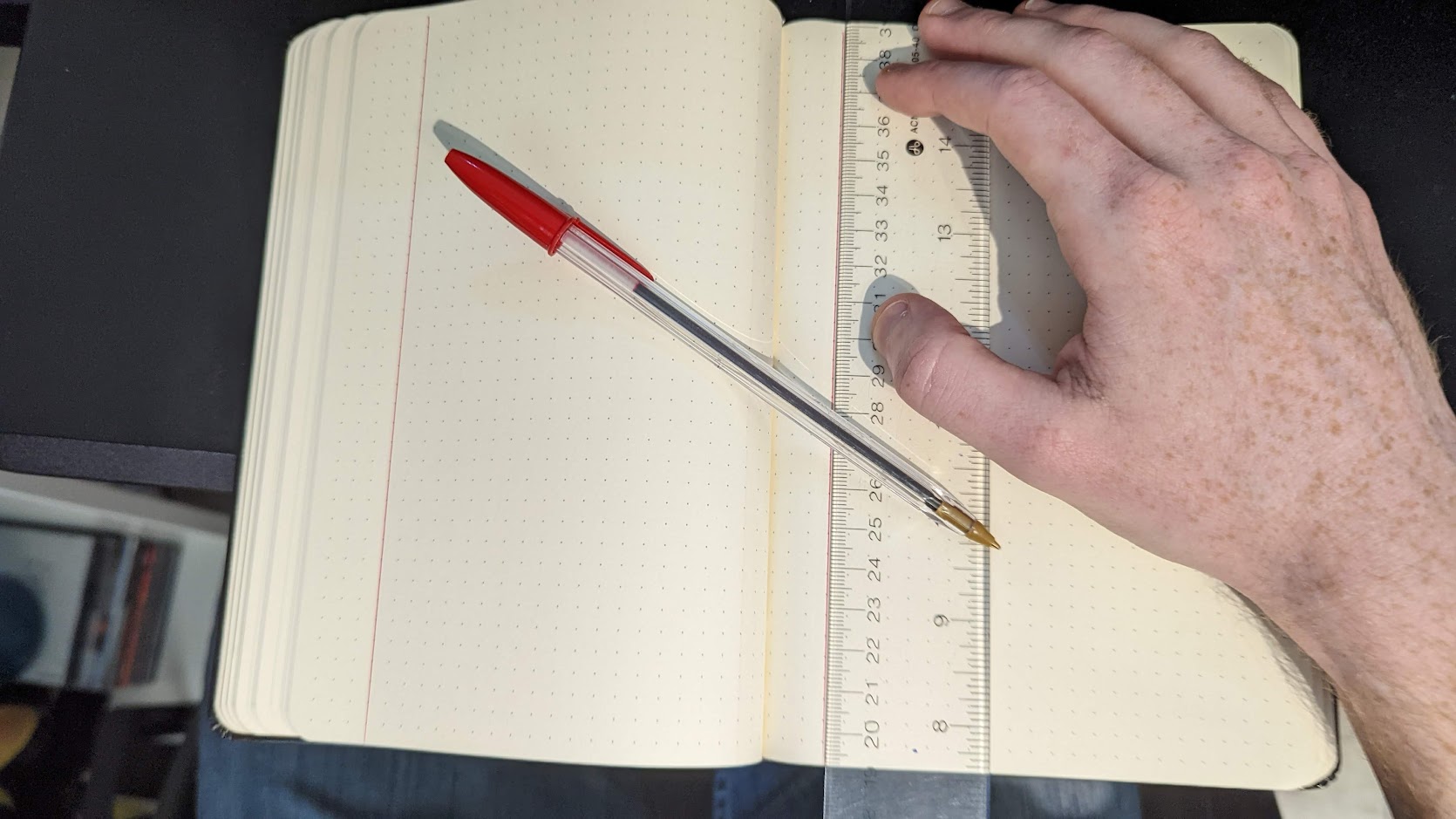
In my notes, sometimes I write questions or things that will need further updates. The margins are the perfect place to put such updates. Of course, not all your notes will require a margin note, but that’s a good thing: it leaves you with more room for the notes that truly need commenting later on.
Idea 14: Write the source of your knowledge nuggets in your margins
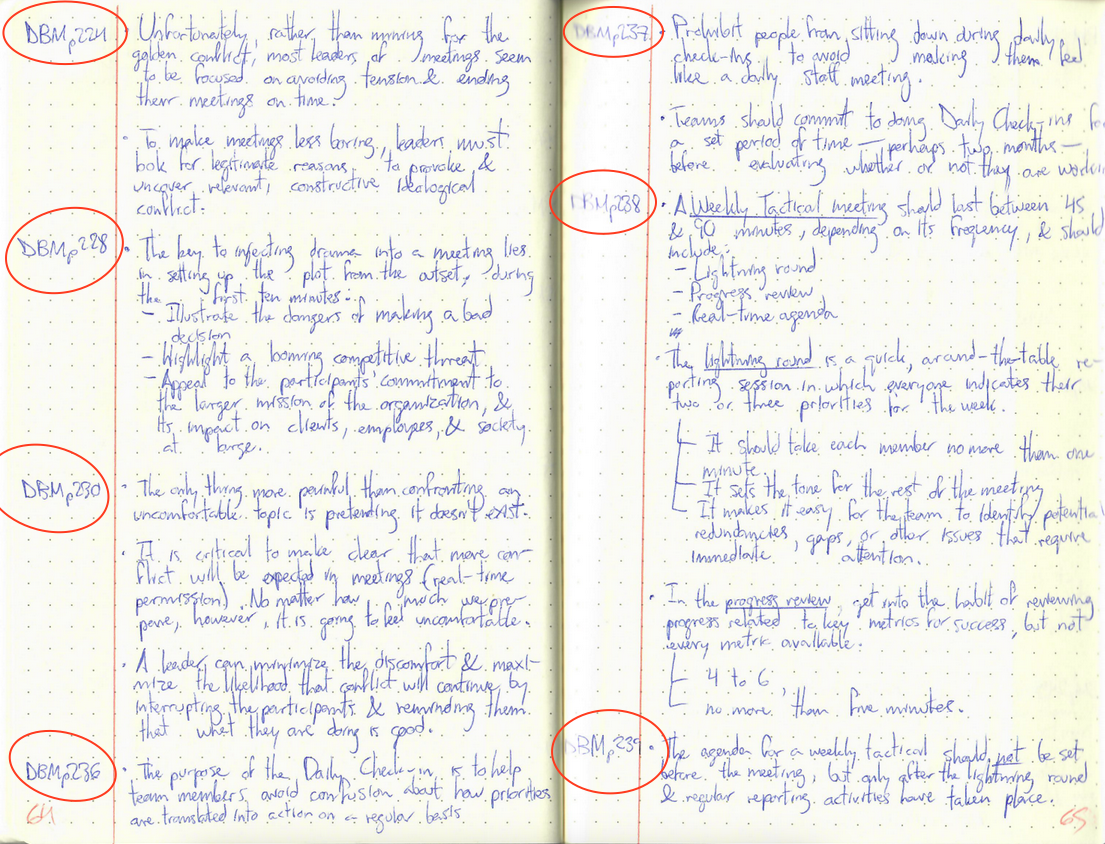
Notice in the photo above that most “knowledge nuggets” are paired with a reference to the source material. This helps finding context or correcting notes in the rare cases where your notes are unclear, and you must refer to the book. Trust me, it can save you a lot of time, and makes sharing that nugget in the future even easier (e.g. “As the DevOps Handbook says on page 49, improvement of daily work is even more important than daily work!”).
Side effects may include people calling you a bookworm.
Idea 15: Use a URL shortener to encode web links in your notebook
This is very nerdy, but also very cool and useful. See an example in the image below:

See that strange (F)/bcm? The circled F is a shorthand for
https://felx.cc. If you visit https://felx.cc/bcm, you’ll be taken to
a much longer Google Photos link (https://photos.google.com/share/AF1QipNkyXbkGnqpbp38J_f57sodGkG80...),
which is a photo I took of a page in a book for convenience. Thus,
https://felx.cc/bcm is my short URL: it is convenient to type on any
device and can redirect me to a much more unwieldy URL.
A URL shortener is a service that allows you to create a small link that can redirect to a link of any length. This is invaluable: it allows me to save important, complicated links directly alongside my reading notes, where I know they will be most useful.
If you are interested in trying a URL shortening service, many services already offer free tiers:
- https://bitly.com/
- https://tinyurl.com/
- https://www.shorturl.at/
- https://cutt.ly/
- https://free-url-shortener.rb.gy/
- https://t.ly/
- …
They all do the same thing. Turn big URLs into small URLs.
However, if you’re a computer nerd and would like to possess your own URL shortening service (like I do with https://felx.cc/, that is fully owned by me!), I recommend you check out a video I made on how to get started with VanityURL.
Idea 16: Give your book away after you’ve written your review
This is the fun part. When you’ve finished reading a book and collected all its nuggets into your journal, you are free to share it with the world. In fact, I think it’s better to remove the book from your home and find it a new library where it will be happy. In my case, since my employer sometimes provides me a personal wellness account that funds my book purchases, I think it’s a no-brainer to bring these books back to the office, where I know they will benefit my colleagues.
Writing the Slack message announcing the newly available book in the library is the victory lap.
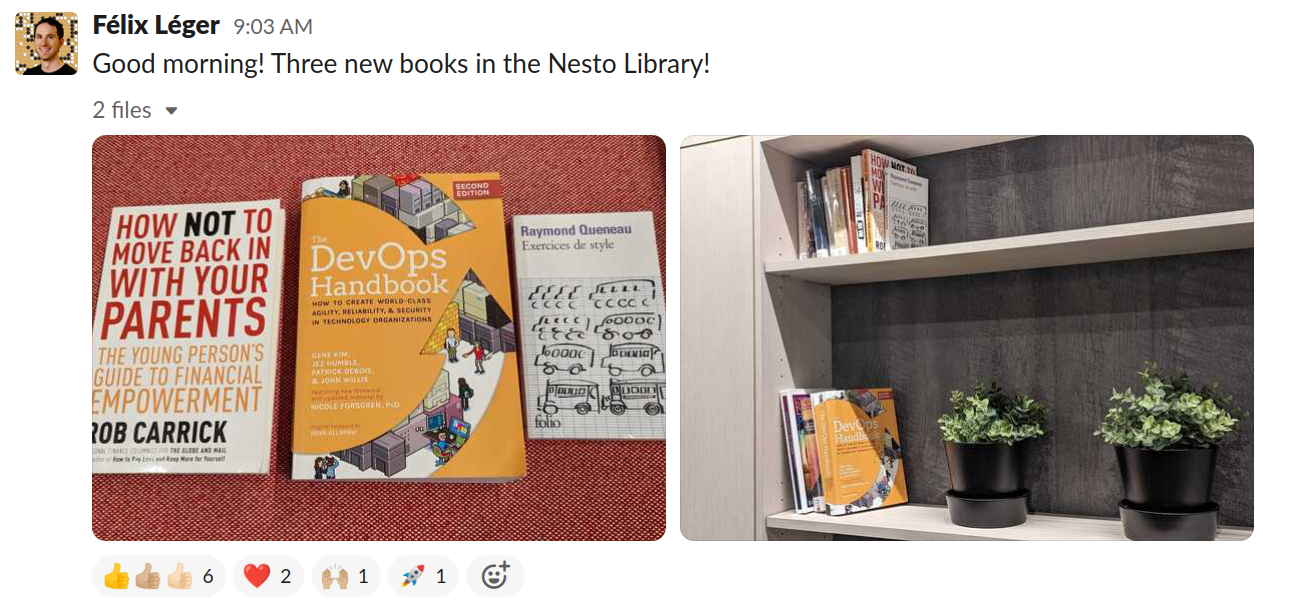
For the DevOps Handbook, since this book meant a lot to me during my personal development, I added a note on the title page. Who knows, maybe this little encouragement will make a difference for the next person who will pick up this book!
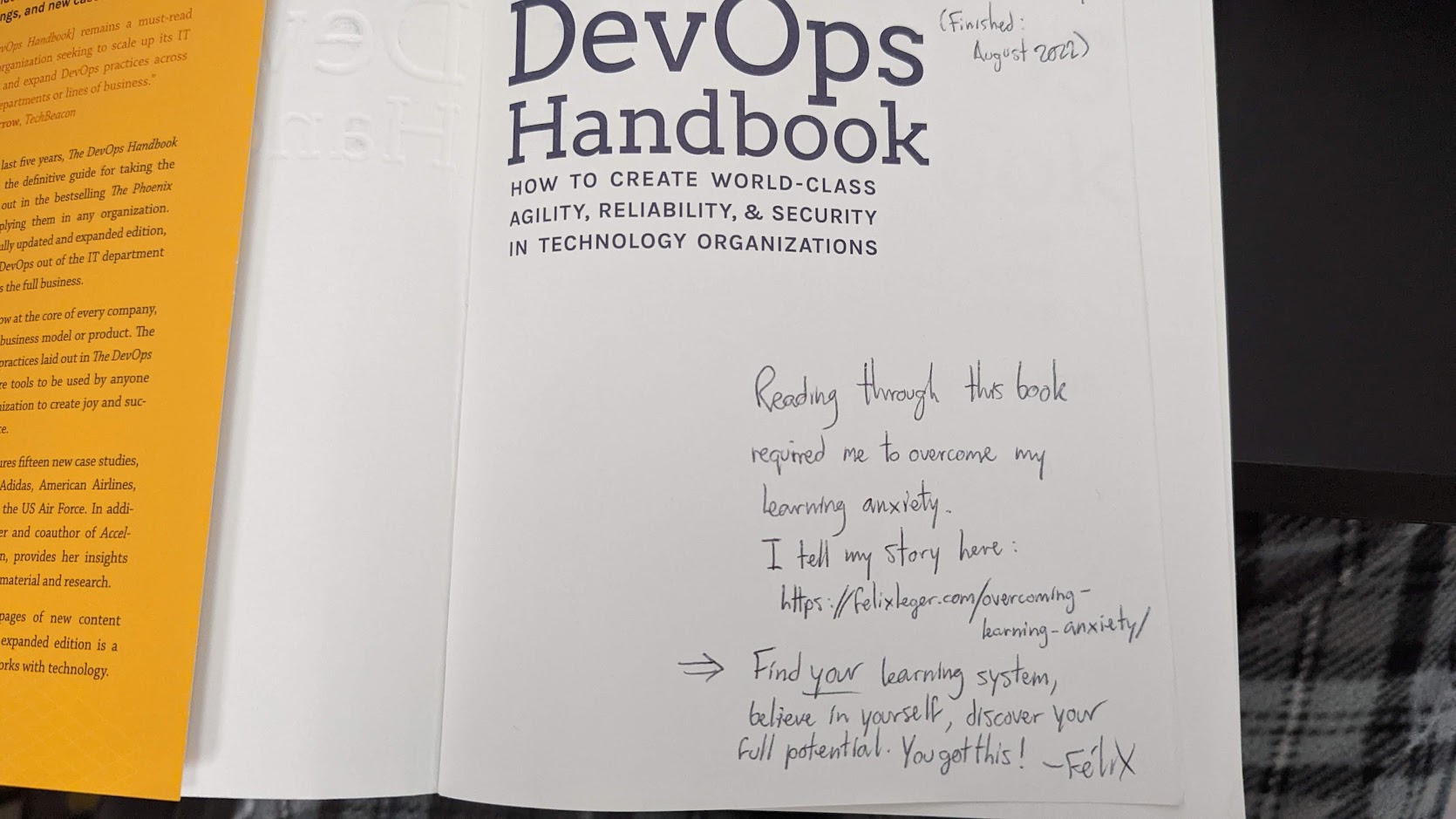
Idea 17: Remember: Reading a book twice is inefficient
I’ve hinted at it before, but I’ll say it clearly once more: Life is too short to read a book in its entirety twice. If you’re reading a book a second time, what does this say about the first time you read it? Instead, rely on your notes to quickly recapture the essence of the book. That’s your reward for putting in the work: you can get the same info as reading the full book in a fraction of the time.
Idea 18: Additional tips on hardware
Bring out the shopping carts, we’re going to talk STUFF.
So, what hardware do I recommend, precisely?
Notebook
First off, this is probably basic common-sense, but I’ll make it explicit, just in case: Don’t use a spiral-bound Hilroy notebook or, worse, a stitched exercise book. These won’t do you much good if pages keep tearing and falling out of your journal after a few years.
The bound journal I’ve been using is the TRU RED Medium Flexible Cover Dotted Journal from Staples.
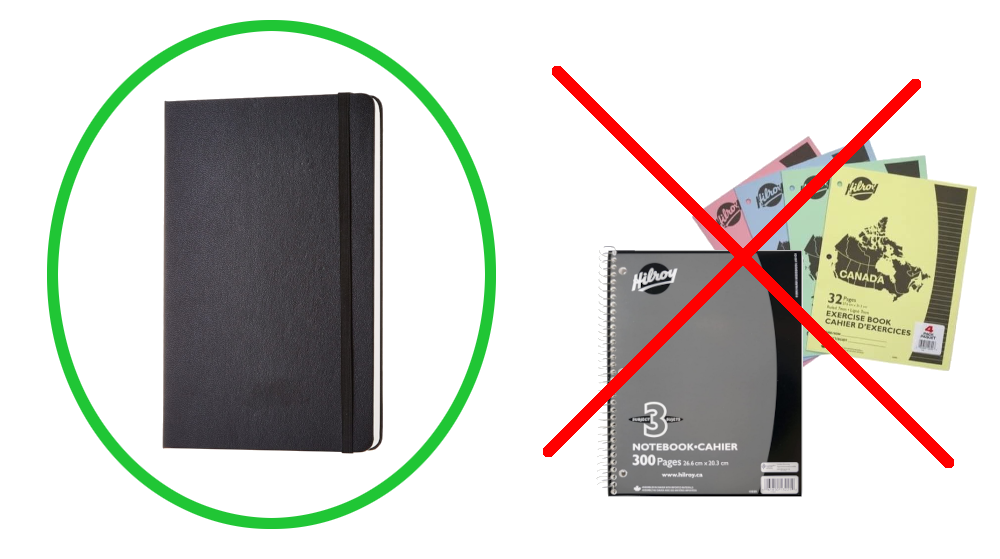
Note: Some people enjoy spiral-bound notebooks because they allow to easily fold back the notebook and stay opened flat on a table. If you do invest in a spiral-notebook, at least make sure it is of high quality.
Also, I strongly recommend using a dotted journal. This allows better horizontal alignment of information for writing lists. It makes my messy handwriting look less messy. Personally, I am now very fond of dotted journals, because they provide the benefits of a grid without being as visually distracting.
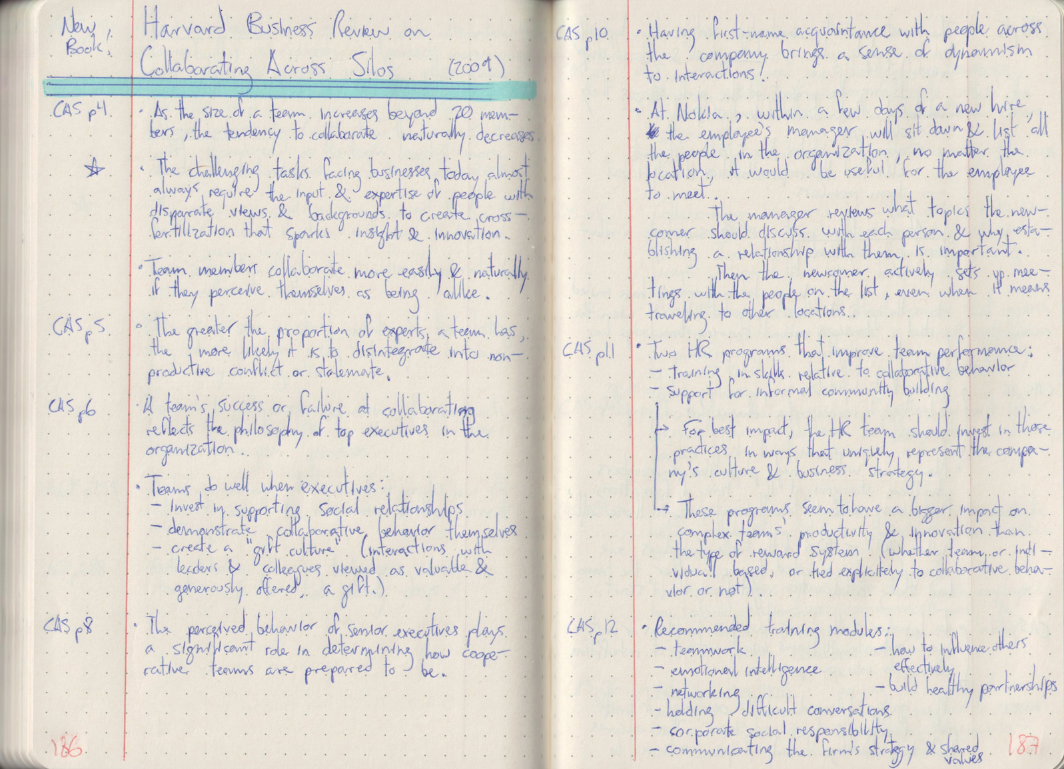
Pens and highlighters
Take the time to really search for a pen that makes writing a joyful experience for you.
If you’re looking for recommendations, mine are:
- Pen: Bic Cristal (black or blue), you can find them anywhere
- Highlighter: Something basic and colorful, like those sold at Staples
Why? Because:
- They are cheap, easy to find and reliable
- The Bic Cristal does not smear (I’m left-handed)
- The highlighter has lots of ink and lasts a long time
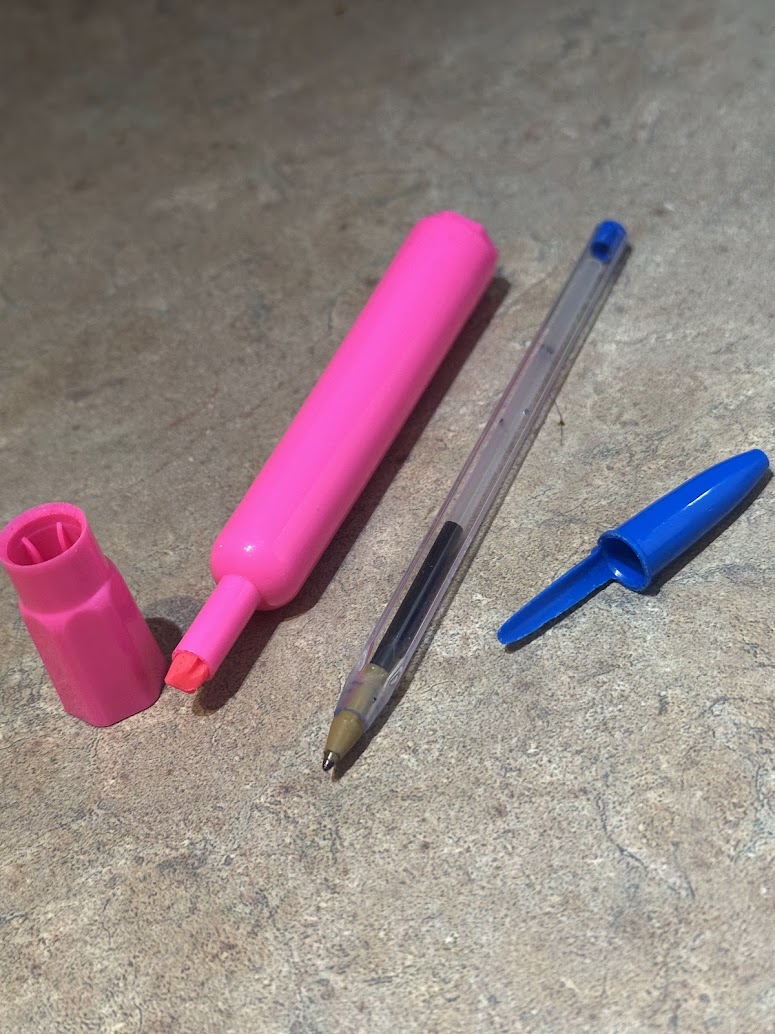
For more details about why I chose the Bic Cristal as my main pen, see The Bic Cristal Story.
Ruler
This allows you to make nice lines, for margins, tables or underlines. Any cheap 15 cm ruler will do. It makes your journal more pleasing to read, which is important. After all, the whole point of keeping a journal is so you can comfortably refer to the knowledge you’ve collected.
The best storage place I’ve found for my ruler is directly in my notebook. It acts like a bookmark. The notebook I recommend above has an elastic band that ensures your ruler would never slip and fall out once shut.

Other things
Here are other things that are part of my toolkit that I briefly discussed in this book:
- The flatbed scanner I use to scan my handwritten notes, as seen in Chapter 6.
- The foldable bag I use when I'm traveling, as seen in Idea #3.
- An alarm clock, as discussed in Idea #4.1.
- A headlamp for reading in the dark, as discussed in Idea #5.
Appendix B: Motivational Quotes
These quotes are lifted from my Star Quotes collection. I hope they will inspire you on your learning journey.
In the absence of improvements, processes degrade over time due to chaos and entropy. Even more important than daily work is the improvement of daily work.
– Gene Kim et al., The DevOps Handbook
Do not envy those who seem to be naturally gifted; it is often a curse, as such types rarely learn the value of diligence and focus, and they pay for this later in life.
– Robert Greene, Mastery
Nothing pleases people more than to go on thinking what they have always thought, and at the same time imagine that they are thinking something new and daring. It combines the advantage of security with the delight of adventure.
– Barry O’ Reilly, Unlearn
Working right trumps finding the right work.
– Cal Newport, So Good They Can’t Ignore You
Could we take what feels like a threat and alter its role in our lives?
– Margaret J. Wheatley & Myron Kellner-Rogers, A Simpler Way
It isn’t the symptoms that predict how much anxiety disrupts a person’s life, it’s how a person feels about those symptoms.
– Emily Nagoski, Come As You Are
Mistakes are goldmines.
– Gustavo Razzetti, Remote Not Distant
Ask yourself: What would I do if I weren’t afraid? And then find a way to go do it.
– Sheryl Sandberg, Lean In
Nobody gets used to feeling dumb.
Nothing is harder than saying, “I gave it my all and it wasn’t good enough.”
Everyone, of whatever age and circumstance, is capable of self-transformation.
You have to apply yourself each day to becoming a little better. By applying yourself to the task of becoming a little better each and every day over a period of time, you will become a lot better.
– Carol S. Dweck, Mindset
Adversity is just the beginning of a challenging sequence that often leads to success.
– Martin Seligman, Learned Optimism
We must have faith that actions today that seem to have no impact in the present moment are in fact accumulating in a positive direction, which will be revealed to us only at some unknown time in the future.
– Anna Lembke, Dopamine Nation
There is no time that is not well suited to study, yet there are many who fail to study when caught up in the problems that give one reasons to study.
Health of body is a temporary condition, and one that no doctor can bestow, though he may restore it. But when the mind if healed, it is once and for all.
What could be more foolish than failing to learn a thing simply because you haven’t learned it earlier?
The sole good is that by which the mind is made better.
A single day gives more time to the educated than the longest of lives for the untutored.
In your study, make it your aim not to know more, but to know better.
– Lucius Annaeus Seneca, Letters on Ethics
The last mile is always the least crowded.
– James Clear, Atomic Habits
Image sources
Chapter 1: The Anxiety Begins
O’Rourke, Alan. “Too Busy To Improve - Performance Management - Square Wheels.” Audience Stack, www.audiencestack.com. Accessed 28 July 2024. [CPP]
Chapter 2: Mount Stupid
Pine, Jordan. “Dunning-Kruger Effect.” Jordan Pine, 2020,
www.jordanpine.com/2020/04/exploit-explained-dunning-kruger-effect.html.
Accessed 28 July 2024. [jjx]
Chapter 4: Opening Pandora’s Box
“Punching Bags, Damaged and Pristine.” Perchance AI Photo Generator,
created by Félix Léger, 2024. [UU8]
Bibliography
Preface
O'Reilly, Barry. Unlearn: Let Go of Past Success to Achieve Extraordinary Results. McGraw-Hill, 2018.
Introduction
Seneca, Lucius Annaeus. Letters on Ethics. The University of Chicago Press, 2015.
Chapter 1: The Anxiety Begins
Greene, Robert. Mastery. Viking Adult, 2012.
Chapter 2: Mount Stupid
Clear, James. Atomic Habits. Avery, 2018.
Chapter 3: Aha!
Smith, Dr. Julie. Why Has Nobody Told Me This Before?: Expert Advice for Navigating Life's Challenges. HarperOne, 2022.
Gene Kim, Jez Humble, Patrick Debois, John Willis. The DevOps Handbook: How to Create World-Class Agility, Reliability, & Security in Technology Organizations. IT Revolution Press, 2021.
Coutu, Diane. “The Anxiety of Learning”, Harvard Business Review, March 2022, https://hbr.org/2002/03/the-anxiety-of-learning.
Chapter 4: Opening Pandora’s Box
Senge, Peter. The Necessary Revolution: How individuals and organizations are working together to create a sustainable world.. US Green Building Council, 2008.
Chapter 5: Climbing the Slope of Enlightenment
Grant, Adam. Originals: How Non-Conformists Move the World. Penguin Books, 2017.
Chapter 6: My Current Learning System
Dalio, Ray. Principles: Life and Work. Avid Reader Press, 2017.
Chapter 7: Profit
Senge, Peter. The Fifth Discipline: The Art & Practice of The Learning Organization. Crown Currency, 2006.
Chapter 8: Conclusion
Wiest, Brianna. The Mountain Is You: Transforming Self-Sabotage Into Self-Mastery. Thought Catalog Books, 2020.
Appendix A: Additional ideas
Doerr, John. Measure What Matters. Portfolio Penguin, 2018.
Appendix B: Motivational Quotes
Gene Kim, Jez Humble, Patrick Debois, John Willis. The DevOps Handbook: How to Create World-Class Agility, Reliability, & Security in Technology Organizations. IT Revolution Press, 2021.
Greene, Robert. Mastery. Viking Adult, 2012.
O'Reilly, Barry. Unlearn: Let Go of Past Success to Achieve Extraordinary Results. McGraw-Hill, 2018.
Newport, Cal. So Good They Can't Ignore You. Piatkus, 2018.
Margaret J. Wheatley, Myron Kellner-Rogers. A Simpler Way. Berrett-Koehler Publishers, 1999.
Nagoski, Emily. Come As You Are: Revised and Updated: The Surprising New Science That Will Transform Your Sex Life. Simon & Schuster, 2021.
Razzetti, Gustavo. Remote Not Distant: Design a Company Culture That Will Help You Thrive in a Hybrid Workplace. Liberationist Press, 2022.
Sandberg, Sheryl. Lean In: Women, Work, and the Will to Lead. Knopf, 2013.
Dweck, Carol S.. Mindset: The New Psychology of Success. Ballantine Books, 2007.
Seligman, Martin E.P.. Learned Optimism: How to Change Your Mind and Your Life. Vintage, 2006.
Lembke, Dr. Anna. Dopamine Nation: Finding Balance in the Age of Indulgence. Dutton, 2023.
Clear, James. Atomic Habits. Avery, 2018.
This text is available in print!
If you enjoyed this text, please consider supporting me by purchasing the print version at https://felx.cc/ola-store. That will allow you to try my four-steps method, as well as the book suplex, in real time!
If you know someone, friends or family, who might benefit from reading this text, please share!

-
This shift from Physics to software is something I previously discussed on my blog in 2019. ↩︎
-
In fact, I was so big on e-readers that I wrote a post titled I Love E-readers where I argue that physical books should be a thing of the past. Oh, the irony, considering I feel uncomfortable whenever I read anything that is not a physical book! ↩︎
-
If you are reading a book for an exam, my learning system might not be perfectly suited to your needs. However, you can use my learning system to read the excellent How to Become a Straight-A Student by Cal Newport. 😉 ↩︎
15685 Words
2022-08-07 19:24
